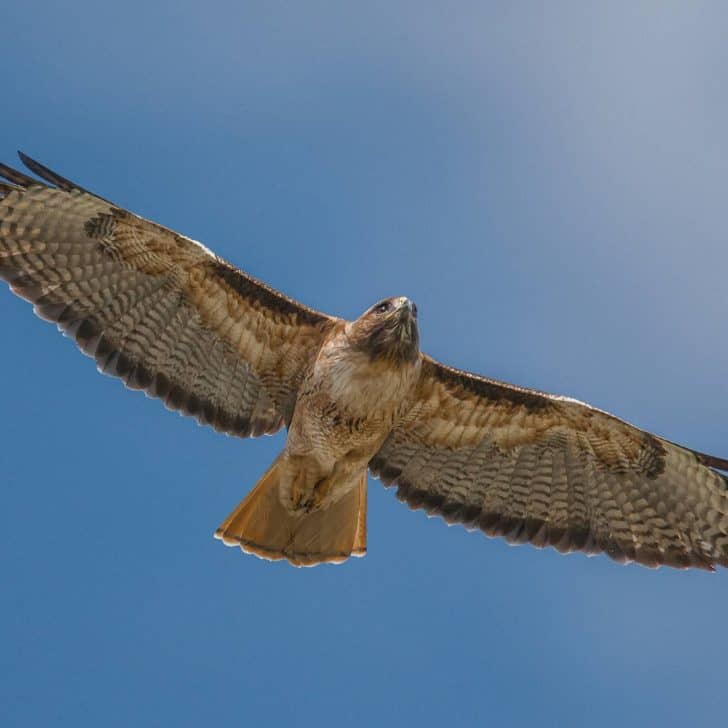California is a diverse state that provides wonderful habitat for a variety of raptors. There are over 30 different California birds of prey that you might see soaring up above, diving for a kill, or calling out into the night sky.
Birds of prey are a group of birds characterized by their predatory behavior and specialized adaptations for hunting. They are known for their exceptional eyesight, sharp talons, hooked beaks, and powerful flight capabilities, which enable them to efficiently capture and subdue their prey.
Birds of prey play important ecological roles as top predators in their ecosystems. They help regulate prey populations and maintain the overall balance of their habitats. They occupy diverse habitats in California, ranging from forests and grasslands to deserts and coastal areas. These birds exhibit a wide range of sizes, shapes, and hunting techniques.
Some common examples of birds of prey include eagles, hawks, falcons, owls, vultures, and harriers. These birds exhibit a wide range of sizes, shapes, and hunting techniques. They occupy diverse habitats in California, ranging from forests and grasslands to deserts and coastal areas.
34 California Birds of Prey You Might See in the Golden State
Eagles That Live in California
1. Bald Eagle
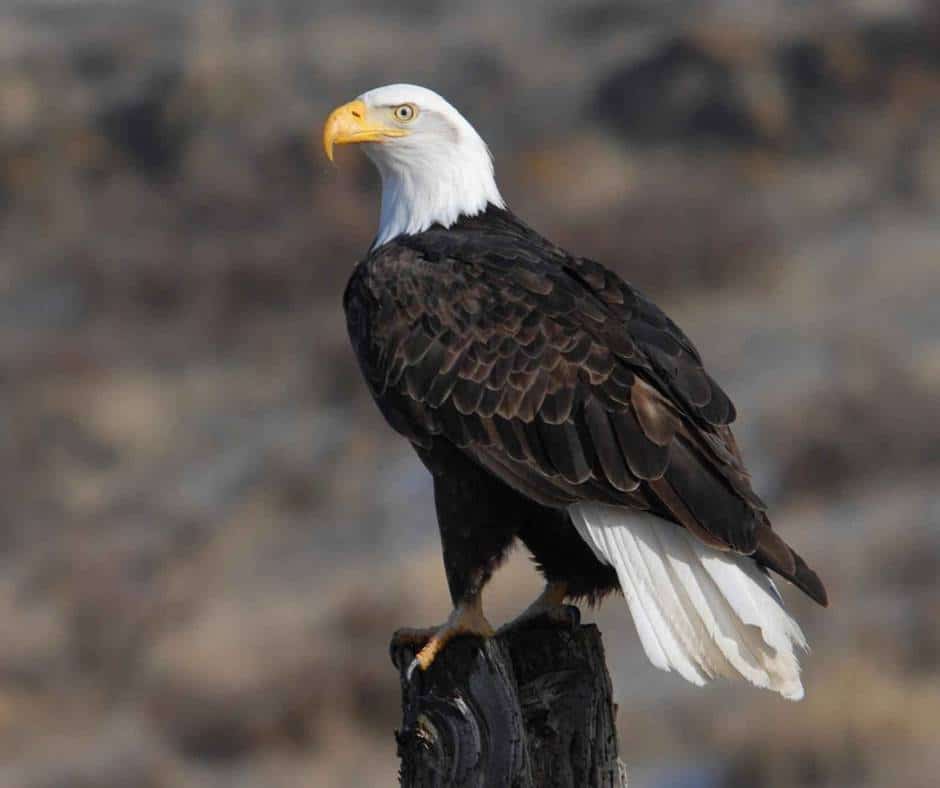
Conservation Status of this California Bird of Prey: Thanks to conservation efforts, the Bald Eagle is now a species of least concern. While the Bald Eagle has a stable population, The Bald and Golden Eagle Protection Act of 1940, prohibits anyone from “taking” bald eagles, including their parts (including feathers), nests, or eggs.
Where in California can I see bald eagles?
According to the California Depatment of Fish and Wildlife, “Bald Eagles are found 41 of the State’s 58 counties,” and, “about half of the State’s wintering bald eagles are found in the Klamath Basin along the California-Oregon border, the location of the largest winter concentration of Bald Eagles in the lower 48 states.”
In all, there are about 1,000 Bald Eagles in California. Some are year round residents but most are only in California through winter. Peak time for spotting Bald Eagles is November through March when they are breeding and hatching new fledglings.
In Northern California, in addition to the Klamath Basin, Bald Eagles are also commonly seen at Shasta Lake and Lake Almanor, thanks to the lakes’ abundant fish populations which attract the eagles. They are also spotted sometimes at Mono Lake on the eastern side of the Sierras.
Bald Eagles have made a comeback in the San Francisco Bay Area in recent years. They can be observed in locations such as Lake Chabot in Castro Valley, Lake Berryessa in Napa County, and Crystal Springs Reservoir in San Mateo County.
In Southern California they are seen most often at Lake Perris, Lake Hemet, Lake Arrowhead, and Catalina Island. There is also a rather famous pair of Bald Eagles that live in Big Bear Lake which have a live bald eagle webcam dedicated to them. The Catalina Island pair has a live cam as well.
Bald Eagle Description and Identification Tips
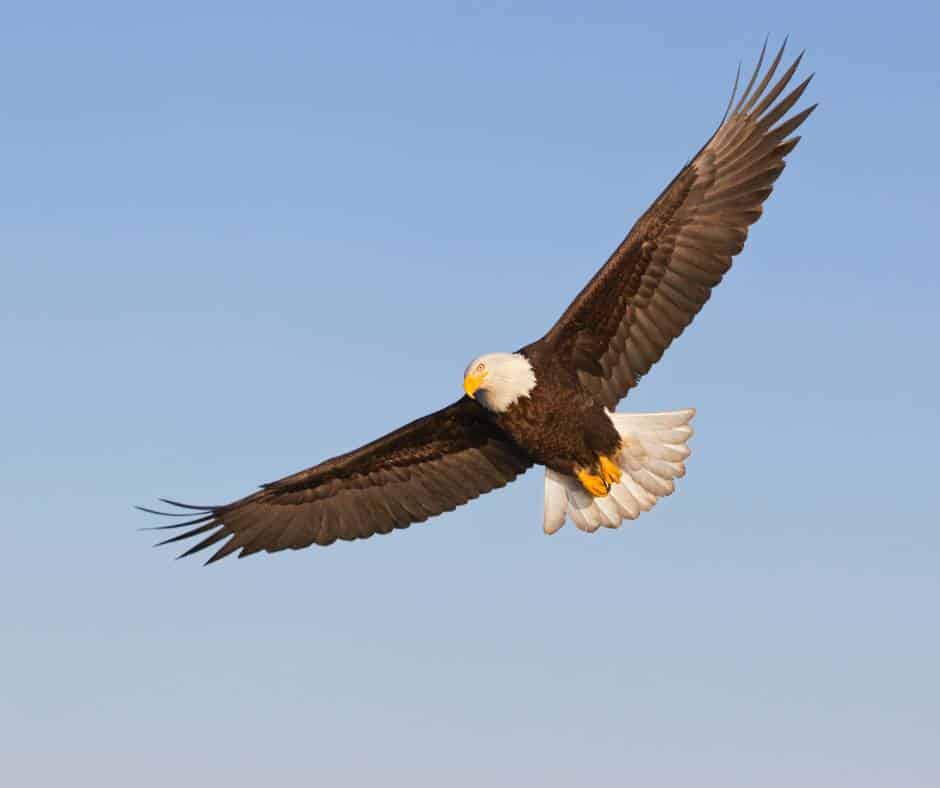
Adult Bald Eagles have a distinctive white head and tail, contrasting with their dark brown body. They have a wingspan of around 6-7 feet and can weigh between 8-14 pounds.
Bald Eagles are primarily fish-eaters and have a diet that consists mainly of fish such as salmon, trout, and herring. However, they are opportunistic hunters and will also feed on small mammals, birds, and carrion. They have powerful talons and sharp beaks to catch and tear their prey.
They prefer to live near large bodies of water such as rivers, lakes, coastal areas, and marshes. Bald Eagles build large nests called “aeries” in tall trees near water bodies. Bald Eagles are monogamous and typically mate for life.
Bald Eagles eggs take 35 days to hatch. Hatchlings learn to fly at around three months of age and fledge about four weeks after that. They reach full maturity at 4-5 years old and typically have a lifespan of 15-25 years in the wild.
Fun Fact: The Bald Eagle was chosen as the national bird and emblem of the United States in 1782 (despite Benjamin Franklin’s lobbying for the turkey). The Bald Eagle appears on the Great Seal of the United States and is widely depicted in American art, currency, and government insignia.
2. Golden Eagle
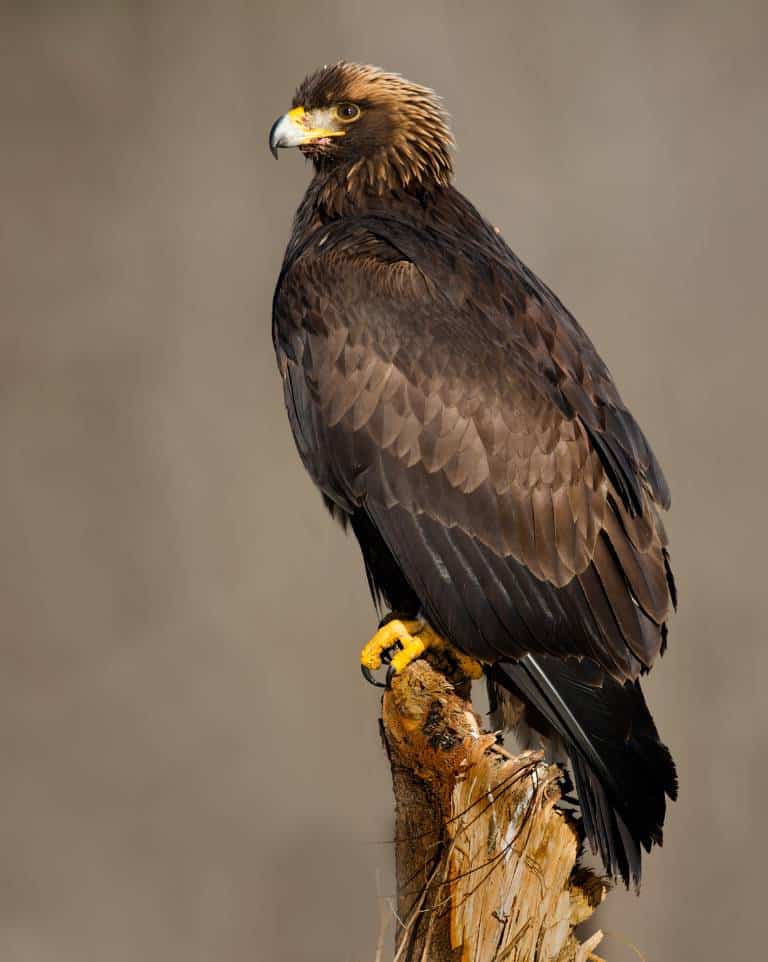
Conservation Status of this California Bird of Prey: While the Golden Eagle has a stable population and is a species of least concern, The Bald and Golden Eagle Protection Act of 1940 prohibits anyone from “taking” golden eagles, including their parts (including feathers), nests, or eggs.
Where in California can I see Golden Eagles?
Golden Eagles can be found up and down the state, but the Bay Area has the largest population of Golden Eagles in the world. There are more breeding pairs around Mount Diablo and the surrounding hillsides than anywhere else.
Unfortunately, wind turbines in the area have had a harmful impact on these majestic birds of prey. According to the California Audubon Society, “Thousands of Eagles have been maimed, injured, and killed by the turbines used to generate wind energy, particularly in Altamont Pass.”
Most Golden Eagles that live in California are year-round residents, but there are some than migrate into California for the winter. In addition to the large Bay Area population, Golden Eagles can be found in forests, canyons, grasslands, and oak woodlands throughout the state. They aren’t seen much in the Central Valley.
Did you know? Golden Eagles started breeding on the Channel Islands thanks to a population of feral pigs, deeer, and endemic Channel Islands fox that provided an easy food source. The result was a catostrophic decline in the fox population, bringing them close to extinction.
The National Park Service made the decision to live trap and relocate the Golden Eagles from 1999-2006. 44 Golden Eagles, including 10 eaglets born on the islands, were trapped and relocated. None have returned and as a result, the fox population has rebounded.
Golden Eagle Description and Identification Tips

Golden Eagles are one of the largest birds of prey in North America. They have a wingspan of about 6 to 7.5 feet and can weigh between 7 to 15 pounds . Adults have dark brown feathers on their body and wings, with a golden-colored head and neck.
Golden Eagles primarily feed on small to medium-sized mammals, such as rabbits, ground squirrels, and marmots. They are also known to prey on birds, including waterfowl and even larger species like cranes and swans. Occasionally, they may scavenge on carrion or even capture larger prey such as deer or sheep.
Golden Eagles are skilled hunters and use their sharp talons and powerful beaks to catch and kill their prey. They are known for their incredible speed and agility in flight, often soaring high in the sky and then diving swiftly to catch their prey.
They are solitary birds, except during the breeding season when pairs come together to raise their young. They do mate for life.
Golden Eagles are known for building huge nests. They are typically 5-6 feet wide and about about three feet deep. They are most often found on cliffs can but also be built on trees, windmills, and even transmission towers. They are not usually city dwellers and stick to more wild spaces with lots of prey.
Female Golden Eagles will lay 1-3 eggs with an incubation period of about 45 days. Eaglets fledge about 7-10 weeks after hatching and juveniles become independent of their parents about 80 days after fledging. They reach maturity at four years of age and generally live 25-30 years.
Vultures That Live in California
3. Turkey Vulture

Conservation Status of this California Bird of Prey: Turkey Vultures are the most widespread vulture in North America and are a species of least concern.
Where in California can I see Turkey Vultures?
Turkey Vultures are the most common bird of prey in California and are found all throughout the state in all sorts of environments such as forests, grasslands, deserts, suburban, and even urban areas. They will basically be found everywhere throughout the state except for the highest elevations.
I live in Orange County and see Turkey Vultures nearly every day. As a matter of fact, we have a large flock that roosts in the wildlands in between two housing developments nearby. They love to circle in the air currents, looking for carrion.
Turkey Vulture Description and Identification Tips
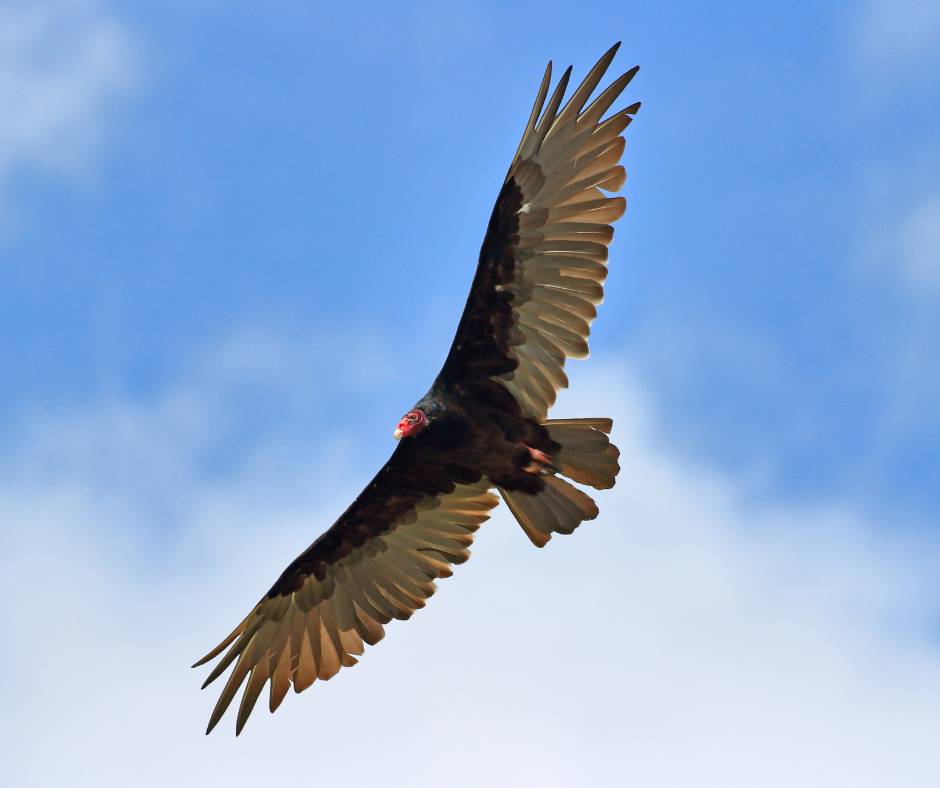
Turkey Vultures have a unique appearance with a bald, red head, a long, hooked beak, and a dark brown to black plumage. They have a wingspan of about 5.5 to 6.5 feet and weigh around 4 to 5 pounds.
They are easy to identify in the air thanks to their light plummage (typically light gray) which forms a “v” from the tips of their wings to their tail. This contrasts with the remaining plummage which is dark brown to black. In flight, their wings form a V-shape and they have a wobbly, rocking motion as they soar.
Turkey Vultures are often seen soaring high in the sky, using thermals (rising columns of warm air) to gain altitude. They have excellent flying abilities and can cover long distances during their flights. When on the ground, they walk with a wobbly, unsteady gait.
Turkey Vultures are primarily scavengers, feeding on carrion (dead animals). They have a highly developed sense of smell, which helps them locate dead animals from a distance. They are not equipped for killing or tearing apart prey like other raptors, but instead rely on their keen sense of smell to locate and feed on decaying carcasses.
Turkey Vultures do not build nests. Instead, they lay their eggs on the ground in caves, hollow logs, or other sheltered locations. They typically lay one to three eggs, which are incubated by both parents. They take about five weeks to hatch.
Babies take about 12 weeks to become fully independent and juveniles take two years to become fully mature. Turkey Vultures live up to 20 years in the wild.
Fun Fact: Turkey Vultures have some pretty gross habits (besides eating decaying animals). One of their main methods of self defense is vomitting their food at an animal that is disturbing it, sending their vomit up to 10 feet in the nuisance’s direction.
Their other gross habit involves them defecating on their feet. They do this for two reasons. First, it cools off their feet in hot weather and second, the digestive juices in their stomach kill bacteria so their feces can act as an antiseptic.
4. California Condor
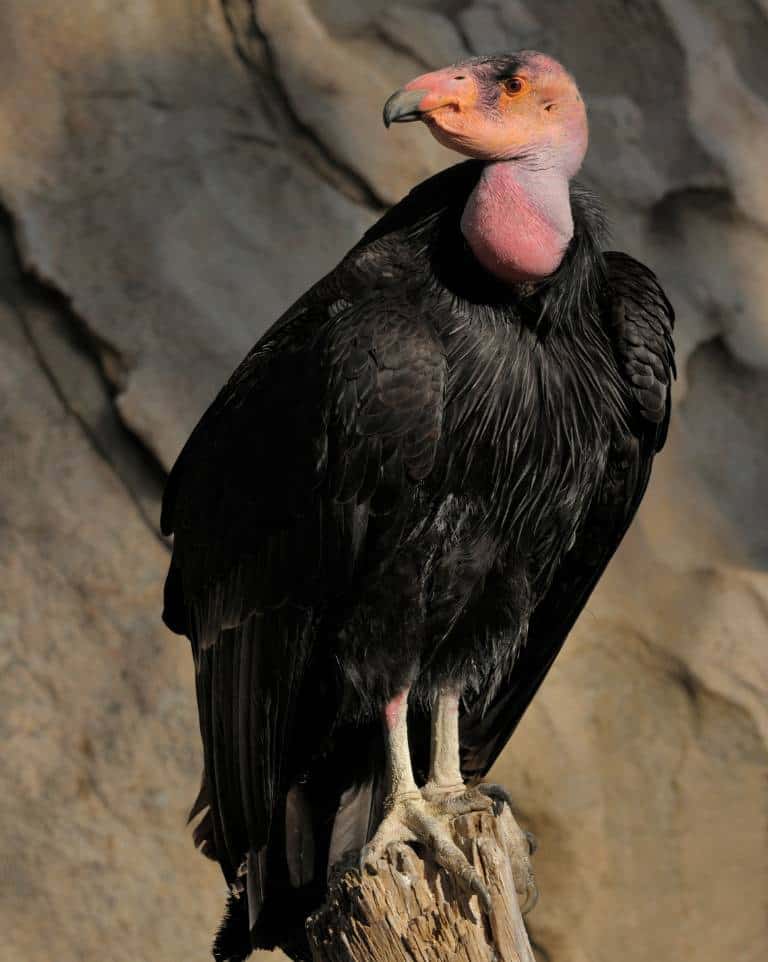
Conservation Status of this California Bird of Prey: The California Condor is Critically Endangered and has been protected as an endangered species by federal law since 1967 and California state law since 1971. At that time, there were only a few dozen condors left in the wild.
In the 1980s, their population reached a low point of only 27 individuals. Through intensive conservation efforts, in large part by the San Diego and Los Angeles Zoos, their population has slowly increased. As of 2022, there were over 561 California Condors.
Where in California can I see California Condors?
The historic range of the California Condor extended across much of North America. However, due to habitat loss, hunting, and poisoning (DDT caused egg shells to be brittle and crack easily and digestion of bullets in animal carcasses resulted in lead poisoning), their population dramatically declined. By the 1970s and 80s, they were only found in a small area of Southern California.
Conservation efforts, including captive breeding and reintroduction programs, have expanded their range, and they can now be found in parts of California, Arizona, Utah, and Baja California, Mexico.
The Southern California Flock at the Hopper Mountain Refuge was established in 1995 and there are 89 birds. The Central California Flock at Pinnacles National Park was introduced in 1997 and there are 94 birds today.
A new Pacific Northwest flock was established in 2022 with eight individuals at Redwood National Park. It is a collaborative effort many decades in the making and the Yurok Tribe has been a large reason for the selection of this particular area for introduction.
California Condor Description and Identification Tips

California Condors are one of the largest flying birds in North America. They have a wingspan of up to 9.8 feet and can weigh up to 26 pounds. They have black feathers with white markings under the wings, and their bare head and neck are pinkish-orange.
California Condors are scavengers and primarily feed on carrion. They rely on their excellent eyesight to locate carcasses from the air. They feed on a variety of animals, including deer, cattle, and smaller mammals. They play a crucial role in cleaning up the environment by consuming carrion and preventing the spread of diseases.
Like other vultures, California Condors do not build nests. They find cavities in rocky cliffs or in the hollows of large redwood trees. Females only lay one egg per nesting cycle. Eggs hatch in about 55 days. Juveniles fledge about six months after hatching. They don’t have adult coloration until they are five years old. They can live for over 60 years, and impressive age for a bird of prey.
Conservation efforts for the California Condor involve captive breeding programs, habitat protection, and public awareness campaigns. The birds are monitored closely, and some individuals are fitted with radio transmitters to track their movements and health. Reintroduction efforts have focused on releasing condors into suitable habitats and reducing threats such as lead poisoning from ammunition fragments in carrion.
5. Black Vulture

Conservation Status of this California Bird of Prey: Black Vultures are considered a species of least concern.
Where in California can I see Black Vultures?
Black Vultures do not breed in California. Instead there are vagrants that seem to be leaving the Arizona population for points north. They have been spotted as far north as Sonoma County in Bolinas, but are mostly seen in California closer to the border. Sometime young Turkey Vultures can be mistaken for Black Vultures.
Black Vulture Description and Identification Tips
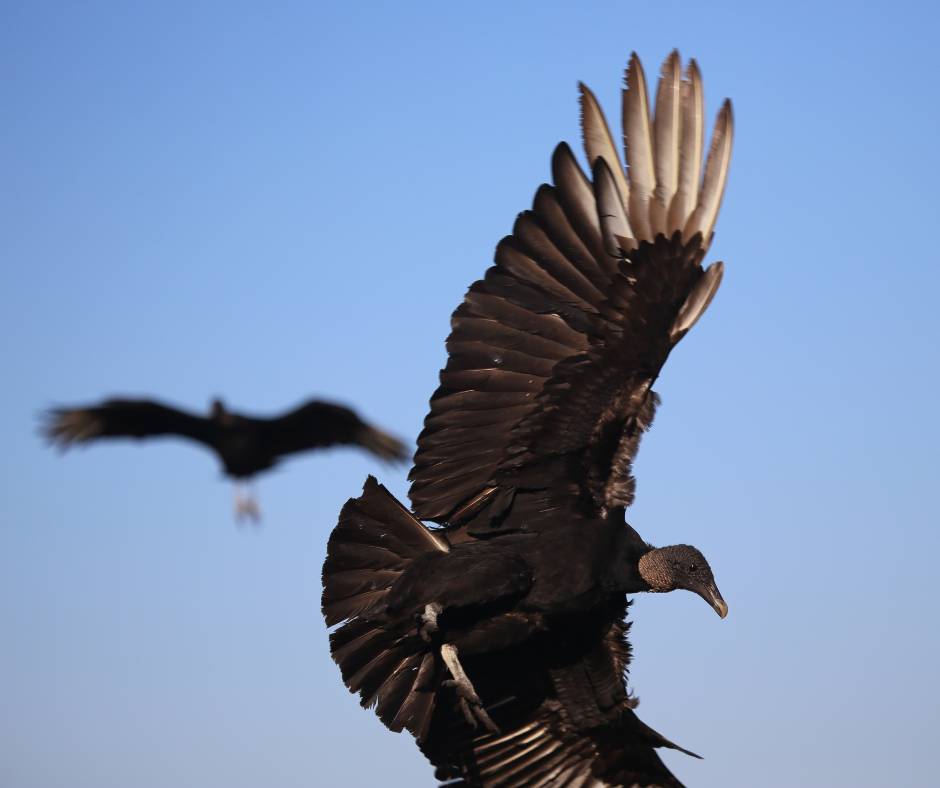
Black Vultures are medium-sized birds with a wingspan of about 4-5 feet and a body length of around two feet. They have black feathers all over their body, including their head and neck. Their legs and feet are grayish-black in color. Unlike other vultures, black vultures have a short, hooked beak.
Black Vultures can be found in a variety of habitats, including forests, open woodlands, grasslands, and urban areas. They are adaptable and can be seen in both rural and urban environments.
Black Vultures are scavengers, feeding primarily on carrion. They have a keen sense of smell and can locate carrion from long distances. They often gather in groups and compete with other scavengers, such as turkey vultures, for food. Flocks can have hundreds of individuals, especially near garbage dumps.
Fun fact: Black Vultures don’t have voice boxes! They will, however, hiss and grunt when bothered.
Hawks That Live in California
6. Red-Tailed Hawk

Conservation Status of this California Bird of Prey: Red-tailed Hawks are considered a species of least concern.
Where in California can I see Red-tailed Hawks?
Red-tailed Hawks are widely distributed across the state and certainly the most commonly spotted hawk in California. They can be seen from the coastline to the desert, and in both wild and urban areas.
The vast agricultural landscapes of the Central Valley provide excellent hunting grounds for Red-tailed Hawks. Look for them perched on fence posts or soaring in the sky.
Along the coastlines of California look for them in areas with cliffs, bluffs, or open fields near the ocean. Red-tailed Hawks can be also found in forested areas throughout the state. They can be spotted soaring above the tree canopy or perched on treetops.
Red-tailed Hawks are adaptable and are often spotted in urban and suburban environments. Look for them perched on light posts, buildings, or in tree-lined neighborhoods. We have a dark morph Red-tailed Hawk that I see in our neighborhood regularly. I usually hear him before I see him soaring above the neighborhood looking for a snack.
Red-Tailed Hawk Description and Identification Tips

Red-tailed Hawks have a wingspan of around 4 to 5 feet and a body length of about 18 to 26 inches. They have broad, rounded wings and a short, wide tail that is often red or reddish-brown, giving them their name. Their plumage can vary but typically includes shades of brown with a pale underbelly and a dark belly band.
Red-tailed Hawks are skilled hunters, primarily feeding on small mammals such as rodents (mice, voles, rabbits), but they also eat birds, reptiles, amphibians, and sometimes carrion. They use their keen eyesight to spot prey from high perches or while soaring, then swoop down to catch it with their sharp talons.
These California birds of prey are known for their impressive aerial displays during courtship, where they engage in thrilling acrobatic flights and aerial courtship rituals. Their loud, high-pitched scream-like calls are often associated with their presence. You can hear them here.
Red-tailed Hawks are solitary birds outside of the breeding season and typically mate for life. They are excellent co-parents and work together to build their nest, incubate the eggs, and raise their young. Red-tailed Hawks tend to lay 2-3 at a time andincubate the eggs for 28-35 days.
Young Red-tailed Hawks stay with their parents for about 10-12 weeks and generally fledge around 45 days. They reach full maturity at 3-4 years of age and live for 10-15 years in the wild.
7. Ferruginous Hawk

Conservation Status of this California Bird of Prey: Ferruginous Hawks are considered threatened. There are currently fewer than 4,000 pairs left on Earth. Their decline is due to hunting and loss of habitat.
Where in California will I find this raptor?
Far less common than the Red-tailed Hawk, the Ferruginous Hawk does use California as a wintering destination. They can be spotted between late September and April in grasslands, sagebrush flats, desert scrub, and low foothills.
They generally prefer open, treeless areas and will roost on a lone tree in the area or even a utility pole. You will not find these raptors in urban areas or heavily treed regions because they do require those wide, open expanses in order to hunt.
The Central Valley offers good habitat for Ferruginous Hawks. Look for them in agricultural areas, grasslands, and open fields. You will also see them in Mojave Desert, Owens Valley east of the Sierra, and Carrizo Plain National Monument which has vast expanses of grassland.
Ferruginous Hawk Description and Identification Tips

Ferruginous Hawks are one of the largest North American hawks, with a wingspan of about 4 to 5 feet and a length of around 22 to 27 inches. They have a robust build with broad wings and a large head.
Their plumage varies depending on the age and geographic location, but adults typically have a rusty or light brown color on their upperparts, while their underparts are pale or white. They have a distinctive white or light-colored throat and a dark belly band. These hawk can be identified in flight by the V that forms as result of their rust legs and white underparts.
They tend to eat small mammals that inhabit grasslands such as rabbits, squirrels, gophers, and mice. They will also eat birds and snakes.
Ferruginous Hawks build large stick nests in trees, shrubs, or on the ground. They may start with an old nest, like a crow’s nest, and then make it much bigger and bulkier with lots of sticks and twigs, as well as cow dung. They often return to their nests year after year, growing them to huge sizes over time.
Fun fact: Back when bison roamed the West, Ferruginous Hawk’s built their nests with sticks and pieces of bison bones, and lined their nests with bison dung!
The female lays around 2-4 eggs, and both parents participate in incubation and raising the young. Ferruginous Hawks co-parent as well, but the mother does most of the nesting and the father does the bulk of the hunting. Eggs hatch after 30-35 days.
The chicks fledge at 45 days and stay a few weeks longer after that to learn to hunt with their parents. The reach full maturity after 3-4 years.
8. Red-Shouldered Hawk

Conservation Status of this California Bird of Prey: Red-shouldered Hawks are considered a species of least concern.
Where in California can I see Red-shouldered Hawks?
The Red-shouldered Hawk is onother one of the more commonly spotted hawks in California. This beautiful bird has a year-round population in the state and can be found in various regions of California, particularly in the central and coastal parts of the state. They prefer habitats with dense woodlands, forests, riparian areas, and wetlands.
It is commonly spotted in riparian woodlands, but it also makes an appearance in residential areas when there is bird feeder attracting song birds that it can easily hunt and eat. It also likes to hang out in eucalyptus groves and oak woodlands.
Red-shouldered Hawks are most commonly spotted in the Santa Monica Mountains, Santa Cruz Mountains, Sierra Nevada foothills, Sacramento Valley, and the coastal areas around San Francisco Bay.
Red-shouldered Hawk Description and Identification Tips

Red-shouldered Hawks are about 17-24 inches long, with a wingspan of approximately 37-43 inches. Generally speaking, they are about the size of a crow and females are larger than males.
These hawks have a distinct reddish-brown coloration on their upper wings and shoulders (no its’s not just a clever name!). They have a barred pattern on their chest and belly, with a white underside. Their tail is marked with dark bands.
In addition to song birds in residential areas, these hawks also eat small mammals (like mice and voles), lizards, and snakes. They hunt from a perch, like a tree, and then swoop down to snag their prey when they spot it.
Red-shouldered Hawks do return to the same nest year after year, so once you have found their “spot”, you can expect to see your new pals again next year. They are monogamous and form long-term pair bonds. They build nests in the forks of large trees using sticks and lined with softer materials such as moss and leaves.
Their nests usually have 3-4 and young hatch after 30-35 days, fledge after six weeks, and stay with their parents for 8-10 weeks longer to get fed and learn how to hunt. They reach full maturity after 2-3 years and live for 10-15 years in the wild.
Explore Southern California with these 20 incredible weekend getaways.
9. Cooper’s Hawk

Conservation Status of this California Bird of Prey: Cooper’s Hawks are considered a species of least concern.
Where in California can I see Cooper’s Hawks?
Cooper’s Hawks are versatile and can be found in a variety of habitats across the state, including forests, woodlands, and suburban areas with ample tree cover. They are particularly fond of edge habitats where they can hunt prey in both open areas and wooded areas.
The Cooper’s Hawk is also a common hawk in urban and suburban areas. While their natural habitat is the forest, they have discovered that they have a taste for doves and pigeons, and they have plenty of both to eat if they stick to where the people are.
If you have a bird feeder, there is a chance that a Cooper’s Hawk might look at it as a smorgasbord, and we aren’t taking about the bird seed! If you do have a hawk that is suddenly using your bird feeder as a hunting ground, remove it for a week and the bird will move on.
Cooper’s Hawk Description and Identification Tips

Cooper’s Hawks have a compact and agile build with rounded wings and a long, rounded tail. Adults have blue-gray upperparts, reddish barring on the chest, and a distinctive black cap on their heads. They have a long tail and shorter wings than a Red-tailed or Red-shouldered Hawk.
Cooper’s Hawks are excellent flyers and move quickly through the air or vegetation to snag their prey. They kill it by squeezing it to death, but they have also been known to drown their prey as well. While they primarily feed on birds, they will also eat small mammals like squirrels and rabbits.
Did you know? Cooper’s Hawks like to eat medium-sized birds, including their own! That’s right, they are cannibals!
A male Cooper’s Hawk is much smaller than a female (they are both around crow size. Males are a small crow, females are a large crow), so it has to be very submissive to the female and send out calls letting her know it is a mate and not food.
Then, the male considers the submission (any thing to make you happy honey, just don’t eat me!) by building the nest and providing all the food for its mate and their young for three months until the young leave the nest.
Cooper’s Hawks are monogamous and typically breed in the spring. They build nests in the dense foliage of trees, usually near the trunk. The female lays 2-6 eggs, which are incubated for about 30-35 days. Both parents participate in feeding the young until they fledge, which occurs around 4-5 weeks after hatching.
10. Sharp-shinned Hawk

Conservation Status of this California Bird of Prey: Sharp-shinned Hawks are a species of least concern.
Where in California can I see Sharp-shinned Hawks?
Sharp-shinned Hawks tend to be winter visitors to California. They can be spotted all across the state in a variety of habitats, including forests, woodlands, and urban areas.
In Northern California look for them at Point Reyes, in the Medocino National Forest, the Sacramento National Wildlife Refuge, and the Lake Tahoe area.
In Central California they are often spotted along the Big Sur coast and in Yosemite National Park. Down south, they are found in desert areas like Joshua Tree National Park and Anza-Borrego Desert State Park as well as destinations close to urban areas like the Santa Monica Mountains and San Diego National Wildlife Refuge.
Sharp-shinned Hawk Description and Identification Tips

Sharp-shinned Hawks look, and in many ways behave, like Cooper’s Hawks, but they are smaller and more secretive.
Like the Cooper’s Hawk, they live in forests but have also adapted to live in urban and suburban areas which are home to lots of songbirds and bird feeders.
So how does one tell a Cooper’s hawk from a Sharp-shinned Hawk? They both have bluish-gray backs, reddish chests, reddish-gold eyes and a blackish-gray cap on their heads. They both have long, banded tails. They are around 10-14 inches in length and has a wingspan of about 20-27 inches.
When in the air, the best identifier is that Sharp-shinned Hawks have square-edged tails while Cooper’s Hawks have rounded tails. If you can see a the hawk perched, take a look at its head. The Sharp-shinned Hawk has a curved head and short neck. The Cooper’s Hawk has a flat head and slightly longer neck.
They are skilled hunters and when the Sharp-shinned Hawk catches their prey, they bang their future meal on a stump or low branch until they die. These hawks tend to eat smaller birds like robins or sparrows, but they will also eat small amphibians and mammals if available.
Sharp-shinned Hawks are monogamous birds and form breeding pairs during the breeding season. Males perform flight displays, which may include swooping, diving, and circular flights to attract the female.
They work together to build the nest and the female lays a clutch of 3 to 5 eggs which are incubated for 28 to 35 days. Young fledge after 25-30 days. They leave their parents after 6-7 weeks and reach full maturity after two years. Sharp-sinned Hawks typically live for 5-10 years in the wild.
11. Northern Goshawk

Conservation Status of this California Bird of Prey: In California, the Northern Goshawk is listed as a Species of Special Concern due to habitat loss and fragmentation.
Where in California can I see Northern Goshawks?
There are about 1,000 breeding pairs in the state of California. Forested regions such as the Sierra Nevada, Shasta-Trinity National Forest, and Lassen National Forest in Northern California are the common locations to see these birds.
In Southern California, the Northern Goshawk is only really seen in the mountains of Los Padres National Forest around Mt. Pinos and Frazier Mountain in northern Ventura County.
Northern Goshawk Description and Identification Tips

The Northern Goshawk is a medium-sized hawk with a stocky build and a broad wingspan of about 40-46 inches. They are fairly easy to identify. Adults have a slate-gray back and wings, a pale gray chest, and a finely barred tail. They have a distinct white eyebrow strip and their eye color is orange to red.
Northern Goshawks are typically found in mature coniferous forests, especially those with dense tree cover. They require a mix of open spaces for hunting and closed canopy areas for nesting.
Northern Goshawks are sit-and-wait predators. They will sit on a treetop and patiently wait until they spot prey like squirrels, woodpeckers, rabbits, or even small birds of prey.
They do breed in monogamous pairs and have huge territories of 2,000-8,000 acres. They build large stick nests high up in trees, usually near the trunk. The female lays 2-4 eggs, and both parents participate in incubation and raising the young.
Goshawks leave the nest after 35-40 days, however they may still rely on their parents for food and guidance for some time after leaving the nest. They reach maturity after 2-3 years and live 10-15 years.
12. Northern Harrier

Conservation Status of this California Bird of Prey: Since heir population is declining, the Northern Harriers is considered a Species of Special Concern in California.
Where in California can I see Northern Harriers?
Northern Harriers can be found in marshes, wetlands, grasslands, agricultural fields, and coastal areas. They prefer open areas with low vegetation where they can hunt effectively.
You are most likely to see this bird in the rice fields or salt water marshes of Northern and Central California. There is a larger winter population but there are some birds that live in the western portion of the state year round.
In Southern California, they have been spotted in marshy areas like the Newport Beach Back Bay, especially during the winter.
Northern Harrier Description and Identification Tips

Northern Harriers have a distinctive appearance. Adult males have a gray body with a white rump and a pale belly. Adult females and immature birds have a brown body with streaks and a more mottled appearance. Both sexes have a white patch near their rump which is a main identifier of this hawk in flight.
These birds are small and light, but their long wings and tails make them appear larger, around the size of a crow. As with nearly all hawks, the females are significantly larger than the males. Harriers fly with their wings higher than their bodies in a v-shape.
Northern Harriers hunt by sound and have a heart-shape facial disk that helps them locate their prey, just like owls. They mainly eat small mammals and birds that live in the marshy areas like mice, voles, and even small ducks.
They fly low over open fields, marshes, and grasslands, using their keen eyesight and hearing to detect small mammals, birds, and other prey. They have a distinctive hovering behavior called “sky-dancing,” where they fly in slow circles or hover in mid-air before diving down to catch their prey.
Northern Harriers are monogamous. The female builds a nest on the ground or in low vegetation, using grasses and other plant materials. They lay 4-6 eggs, and both parents take turns incubating them for about a month. After hatching, the young birds stay in the nest for a few weeks before they start flying at about 30-35 days.
After fledging, the young Northern Harriers still rely on their parents for food and guidance for some time until they become fully independent. These birds reach full maturity after two years and typically live for 10 years.
13. White-Tailed Kite

Conservation Status of this California Bird of Prey: The White-tailed Kite is considered a species of least concern but it is fully protected under California law.
Where in California can I see White-tailed Kites?
The largest population of White-tailed Kites in North America is found in California, mainly in the grassy lowlands west of the desert.
They like farmland, wetlands, and open grasslands. They prefer areas with nearby perches, such as trees, power lines, or fence posts, from where they can hunt.
They will roost in trees on the edges of these more open areas. When they aren’t breeding, you can often find White-tailed Kites roosting together in great numbers, sometimes up to 100 birds will hang out together in a small cluster of trees!
Look for white-tailed kites in the Sacramento Valley, San Joaquin Valley, San Francisco Bay Area, Central Coast, and Southern California. You may find them soaring in the air or perched on elevated spots like utility poles, dead trees, or fence posts.
White-tailed Kite Description and Identification Tips

The White-tailed Kite is a small to medium-sized bird of prey with a distinctive appearance. It has a slender body, long wings, and a white head and underparts. The upperparts are gray, and the tail is white (hence the name) with a black band near the end. Eyes are generally orange or red.
This bird eats mostly mice, voles, and gophers, and hunts by hovering above the ground with its wings flapping and its head tipped down. This behavior is called “kiting”. When it sees movement of a mouse or vole on the ground, it then darts down to grab it.
White-tailed Kites are monogamous and form pairs that last for multiple breeding seasons. They build nests made of sticks in tall trees, shrubs, or sometimes on man-made structures like telephone poles. The female typically lays 3-4 eggs, which both parents take turns incubating. The chicks hatch after about a month, and both parents participate in raising and feeding them.
White-tailed Kites typically fledge after about 4-5 weeks. After fledging, they continue to be dependent on their parents for several more weeks as they learn to hunt and become proficient flyers. They reach maturity after one year and live for 5-10 years.
14. Swainson’s Hawk

Conservation Status of this California Bird of Prey: Swainson’s Hawks are considered a species of least concern.
Where in California can I see Swainson’s Hawks?
Swainson’s Hawks are migratory birds, spending their breeding season in North America and migrating to South America for the winter. During the breeding season, they can be found in a variety of habitats across the western portion of California, including grasslands, prairies, agricultural fields, and open woodlands.
Swainson’s Hawks are commonly found in the agricultural areas of the Central Valley, including the Sacramento Valley and San Joaquin Valley. They are known to nest in trees and utility poles in these areas. They are also seen in Tule Lake National Wildlife Refuge near the Oregon border.
In Southern California, you will Swainson’s Hawks at Carrizo Plain as well as many other coastal and inland destinations as theey migrate through the area.
Swainson’s Hawk Description and Identification Tips

Swainson’s Hawks are medium-sized birds with a wingspan ranging from 4 to 4.5 feet and typically weigh between 1.2 to 2.2 pounds. They have long, slim wings and a relatively small head. Adults have dark brown plumage on their upperparts and a white or pale underbelly with reddish-brown barring. They also have a distinctive white throat patch.
Swainson’s Hawks primarily feed on small mammals, such as rodents, rabbits, and ground squirrels. They also consume a variety of birds, reptiles, and insects. They are known to forage while soaring in the air, searching for prey on the ground.
Swainson’s Hawks are known for their impressive migration patterns. They undertake one of the longest migratory journeys of any North American raptor, traveling thousands of miles from their breeding grounds in North America to their wintering grounds in South America. During migration, they often form large flocks known as kettles, where they soar together in thermal updrafts.
Swainson’s Hawks exhibit an interesting feeding behavior known as “kiting.” They hover in the air, facing into the wind, and flap their wings vigorously while scanning the ground for prey. This behavior allows them to maintain a stable position in the air while hunting.
Swainson’s Hawks are monogamous and form long-term pair bonds. They build large stick nests in trees or on utility poles. The female typically lays 2 to 4 eggs, and both parents take turns incubating them for about a month.
The young birds leave the nest after about 5 to 6 weeks but may stay near their parents for a period of time. Swainson’s Hawks reach maturity after 2-3 years and live for 10-15 years.
15. Zone-tailed Hawk
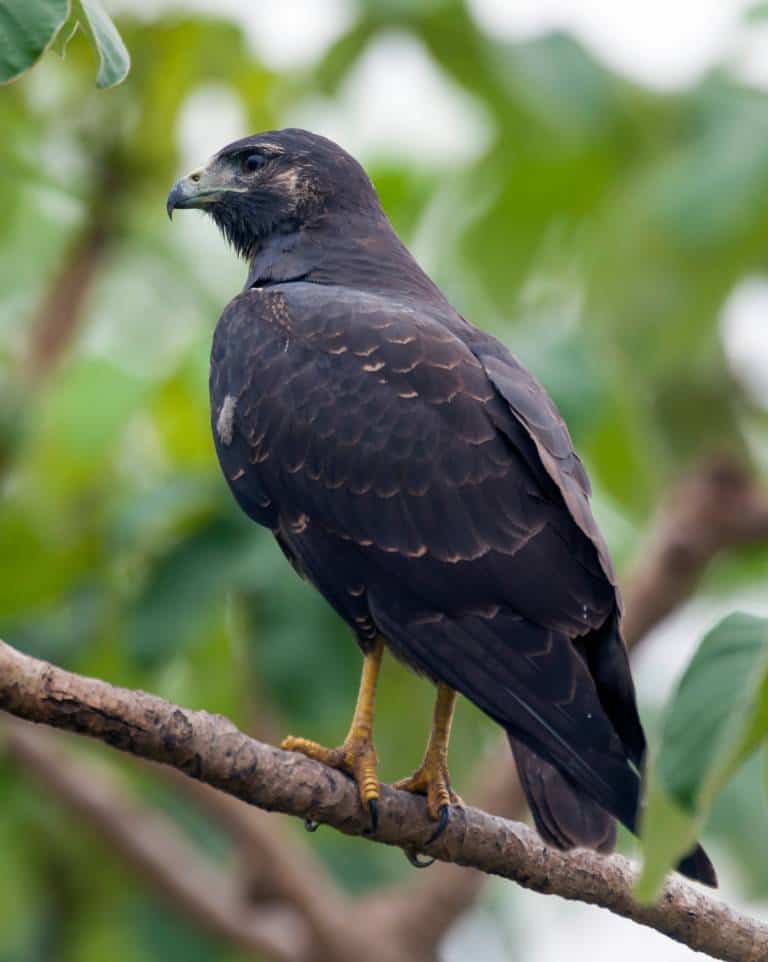
Conservation Status of this California Bird of Prey: The Zone-tailed Hawk is considered to be a species of least concern.
Where in California can I see Zone-tailed Hawks?
The Zone-tailed Hawk is typically found in forested areas, including riparian woodlands, canyons, and mountainous regions. These birds of prey prefer habitats with large trees and open spaces, where they can hunt for prey.
Zone-tailed Hawks are migratory birds, spending their breeding season in the southern United States and Mexico, and migrating to Central America for the winter.
In Central and Southern California, you may find Zone-tailed Hawks in areas such as the coastal regions, deserts, and mountainous regions that have wooded areas near rivers or streams. They are not a common site in California, so if you spot one, take time to enjoy it!
Zone-tailed Hawk Description and Identification Tips
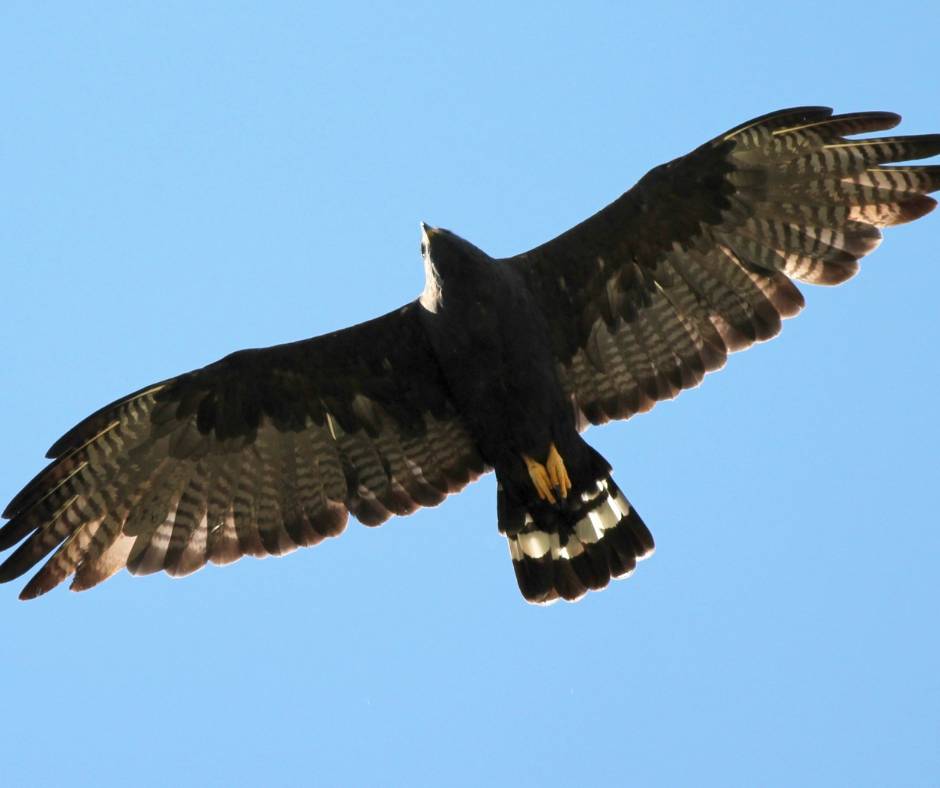
The Zone-tailed Hawk is a medium-sized raptor with a wingspan of around 3.5 to 4 feet and a length of about 17 to 20 inches. It has a dark brown or blackish plumage with a pale grayish-brown barred belly and distinctive whitish bands on its tail. The wings are broad and rounded.
The Zone-tailed Hawk resembles the Turkey Vulture in flight, as it has similar coloring and patterns. However, when perched, it can be distinguished by its broad wings, relatively short tail, and dark plumage. They also have feathered heads while Turkey Vultures do not.
The Zone-tailed Hawk primarily feeds on small mammals, birds, reptiles, and insects. It is known for its unique hunting behavior, where it often flies among groups of Turkey Vultures, taking advantage of their presence to remain inconspicuous and surprise its prey. This clever hunting adaption is called mimicry.
These hawks are monogamous, typically build stick nests in tall trees and may reuse nests from previous years. Females lay one to three eggs, which are incubated for about 30 to 35 days. The young birds fledge and become independent after around 45 to 50 days. Maturity is reached after 2-3 years and their lifespan is 10-15 years in the wild.
16. Rough-Legged Hawk

Conservation Status of this California Bird of Prey: The Rough-legged Hawk is a species of least concern.
Where in California can I see Rough-legged Hawks?
Rough-legged Hawks are migratory birds. They breed in the Arctic during the summer months and then migrate south for the winter. In winter, look for them perched on poles, trees, or hovering in search of prey.
Throughout the state, look for them in grasslands, agricultural fields, marshes, and open woodlands. You are not likely to see them around forests. Sacramento National Wildlife Refuge, Colusa National Wildlife Refuge, and Modoc National Wildlife Refuge are some of the places you might see them.
Rough-legged Hawk Description and Identification Tips

The Rough-legged Hawk has a wingspan that ranges from about 52 to 58 inches and weighs between 1.2 to 3.3 pounds.
They have a stocky build with broad wings and a feathered facial disk that resembles an owl. The adult plumage varies, but it typically features dark brown to black feathers on the body, a white or light-colored head and underparts, and a dark belly band or bib. They have feathered legs that extend all the way to their toes, giving them a rough-legged appearance.
Rough-legged Hawks are known for their hovering behavior, similar to that of a kestrel. They hover in the air while scanning the ground for prey. They are skilled hunters, primarily feeding on small mammals like voles, mice, lemmings, and ground squirrels. They will perch on elevated perches, such as fence posts or trees, from which they can spot potential prey.
Rough-legged Hawks are monogamous and form pair bonds that can last multiple breeding seasons. They build nests on cliffs or high trees using sticks and lined with grass and other soft materials. The female usually lays 2 to 6 eggs, and both parents participate in incubating them for about a month.
The chicks fledge after around 5 to 6 weeks and become independent within a few months. Rough-legged Hawks generally reach maturity at around two to three years of age. Their lifespan in the wild is typically around 10 to 15 years.
17. Broad-Winged Hawk
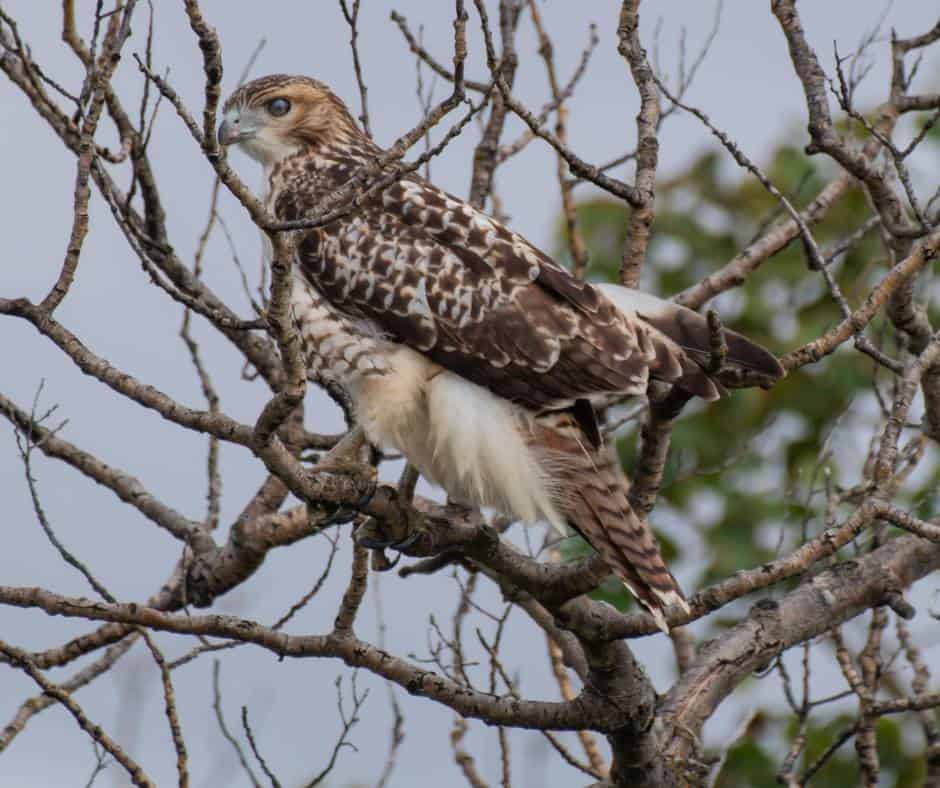
Conservation Status of this California Bird of Prey: Broad-winged Hawks are a Species of Least Concern.
Where in California can I see Broad-winged Hawks?
In California, the Broad-winged Hawk is considered a rare visitor during migration. They have been spotted at the Marin Headlands in Northern California as well as far south at Point Loma in San Diego.
They can be seen primarily during the fall migration. Birdwatchers and hawk enthusiasts often keep an eye out for this species during the migration season in woodlands, edges, and forested wetlands
Broad-winged Hawk Description and Identification Tips

Broad-winged Hawks are relatively small hawks with a body length of about 14-17 inches and a wingspan of approximately 31-37 inches. They have a stocky build, broad wings, and a short, rounded tail. Adult birds have dark brown upperparts with a rufous-barred belly and a white or pale underwing with dark wingtips.
Broad-winged Hawks are known for their distinctive behavior of migrating in large flocks called “kettles” during the fall migration. These flocks can consist of hundreds or even thousands of hawks soaring and spiraling together in thermal updrafts. They are also skilled hunters, preying on small mammals, birds, reptiles, and amphibians.
These hawks are monogamous and form pair bonds that can last multiple breeding seasons. They build nests in the crotch of a large deciduous tree. The female typically lays two to four eggs, which are incubated by both parents for about 30 days. The young fledge after about six weeks and become independent shortly thereafter. Maturing happens after three years and typically live 12-15 years.
Falcons
18. Peregrine Falcon

Conservation Status of this California Bird of Prey: Previously endangered, the Peregrine Falcon was delisted in 2009, but it is still a fully protected species.
Where in California can I see Peregrine Falcons?
Peregrine Falcons have a widespread range in California, occupying a variety of habitats throughout the state. They can be found along the coast, in mountainous regions, and in urban areas.
Locations such as Big Sur, Point Reyes National Seashore, Channel Islands National Park, and the Farallon Islands provide suitable habitat for nesting pairs.
Yosemite National Park and Kings Canyon National Park are wonderful places to observe Peregrine Falcons in the Sierra Nevada. Cities with tall buildings like San Francisco and Los Angeles have nesting pairs that can be observed as well. You can find these amazing birds from the big cities to the suburbs to the forest.
Peregrine Falcon Description and Identification Tips
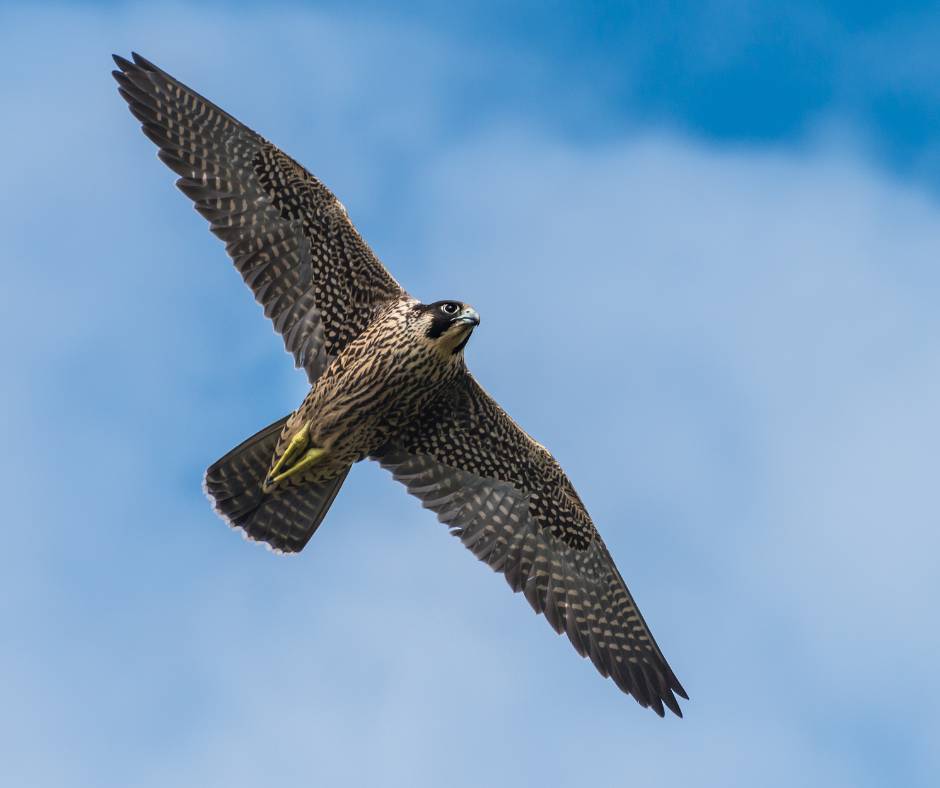
Peregrine Falcons are medium-sized raptors, with adult males measuring around 15-20 inches in length and having a wingspan of about 40-45 inches. Females are slightly larger. They have a compact and streamlined body and long pointed wings. The head is dark with a distinctive black “mustache” mark on each side.
Peregrine Falcons are renowned for their exceptional speed during hunting. They are one of the fastest animals on the planet, capable of reaching speeds over 240 miles per hour in a stoop, which is a steep dive they use to strike their prey. They primarily feed on birds, which they capture mid-air by diving from great heights and striking their prey with their sharp talons.
These California birds of prey faced a significant decline in the mid-20th century due to the widespread use of pesticides like DDT, which caused thinning of eggshells and reduced reproductive success. However, conservation efforts, including banning the use of these chemicals, have led to a remarkable recovery of their populations.
Peregrine Falcons are monogamous and form long-term pair bonds. They construct nests called “scrapes” on ledges, cliffs, or tall structures. Females typically lay 3-4 eggs, which are incubated by both parents for about a month.
The chicks hatch and are cared for by their parents until they fledge, which usually occurs after about 6 weeks. They reach maturity after 2-3 years and live for 10-15 years in the wild.
19. Prairie Falcon
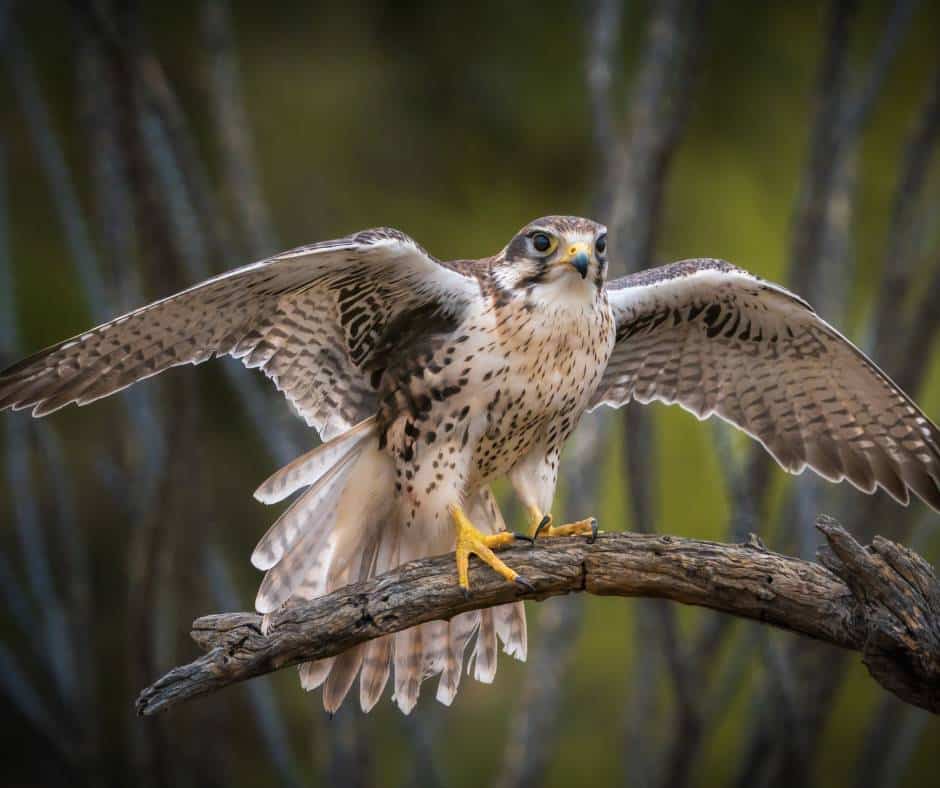
Conservation Status of this California Bird of Prey: Prairie Falcons are a species of least concern.
Where in California can I see Prairie Falcons?
Prairie Falcons can be found in various regions of California, including the Central Valley, Mojave Desert, and parts of the Sierra Nevada. They prefer open habitats with suitable nesting cliffs and abundant prey populations. Look for them in grasslands, shrublands, deserts, canyons, and on rocky outcrops or cliffs.
Prairie Falcon Description and Identification Tips
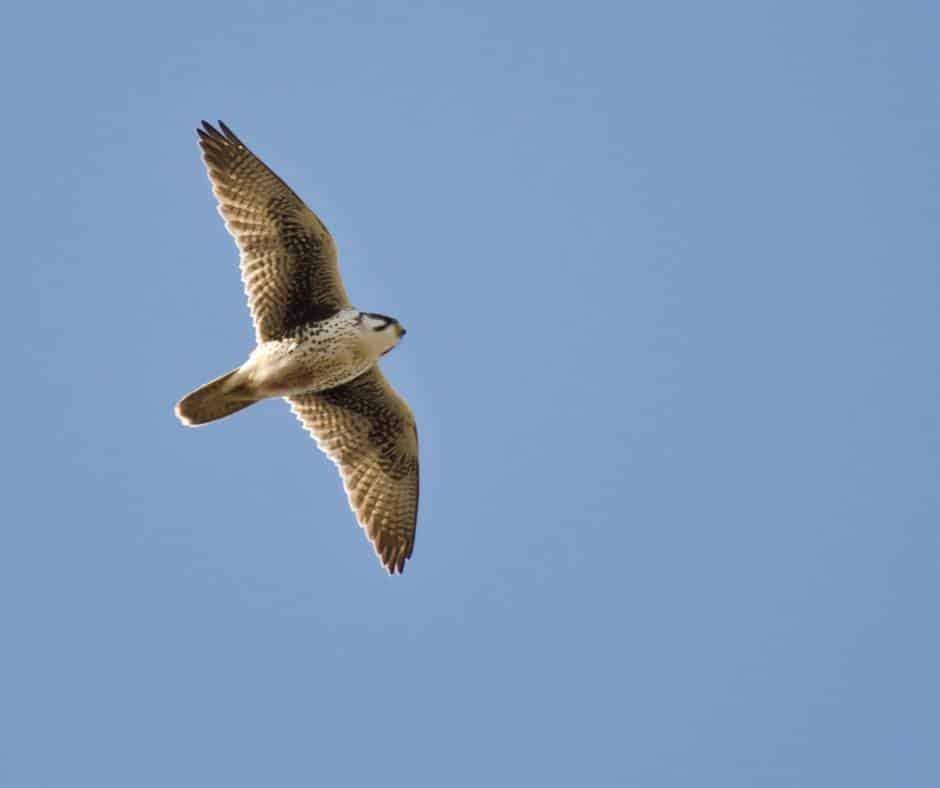
Prairie Falcons have a compact and muscular body with a wingspan ranging from 3.3 to 3.9 feet. They have a dark brown or grayish-brown back and wings, with a paler underbody that may have fine streaks or barring. Their tail is long and tapered, and their face shows a distinctive dark mustache mark.
Prairie Falcons are agile and swift fliers, known for their powerful and fast hunting flights. They primarily feed on small to medium-sized birds, such as songbirds, waterfowl, and shorebirds. They may also prey on mammals, reptiles, and insects.
Like other falcons, Prairie Falcons are known for their ability to engage in high-speed stoop attacks, diving from great heights to capture prey. Prairie Falcons are known for their distinctive vocalizations, which include a series of harsh, raspy calls. They are territorial birds and often defend their nesting areas against intruders, including other raptors.
Prairie Falcons are monogamous and form breeding pairs. They build their nests on ledges or in crevices on cliffs, often reusing the same site in subsequent years. The female typically lays 3 to 5 eggs, which are incubated by both parents for about 30 days.
The young falcons fledge after about 5 to 6 weeks and become independent within a few months. They reach maturity at 1-2 years of age and live for 12-15 years.
20. American Kestrel

Conservation Status of this California Bird of Prey: American Kestrels are a species of least concern.
Where in California can I see American Kestrels?
American Kestrels are found throughout California, in various habitats such as grasslands, agricultural areas, coastal regions, and open woodlands. They are a relatively common and widespread species in the state. They are often perched on wires, poles, or trees, and their hovering hunting behavior can be fascinating to watch.
American Kestrel Description and Identification tips

American Kestrels are small falcons, measuring just 9 to 12 inches in length and having a wingspan of approximately 20 to 24 inches. They weigh only 3-5 ounces.
Males and females exhibit sexual dimorphism, meaning they have different appearances. Males have a distinctive coloration with blue-gray wings, a rusty-red back, and a white and rusty-red belly with black spots. Females are larger and have a similar color pattern but with more brown tones.
American Kestrels are active hunters, primarily feeding on small mammals, insects, and small birds. They have a distinctive hunting style, hovering in mid-air and rapidly flapping their wings while scanning the ground for prey. They are also known for their ability to perch-hunt, where they observe the surroundings from a high vantage point and swoop down to catch prey.
American Kestrels are cavity nesters, often using abandoned woodpecker holes or nest boxes as their nesting sites. The female typically lays 4 to 6 eggs, which are incubated by both parents for about 30 days. The young kestrels fledge after about 4 to 5 weeks and may continue to be cared for by the parents for some time.
They reach matuiry after one year but often don’t breed until the second year. They live for 5-10 years.
21. Merlin

Conservation Status of this California Bird of Prey: Merlins are a Species of Least Concern.
Where in California can I see Merlins?
Merlins can be spotted along the California coast, including coastal woodlands, open beaches, and estuaries. Keep an eye out for them perching on trees, utility poles, or scanning for prey over the water.
Merlins are adaptable and can be found in urban and suburban environments, including city parks, golf courses, and open spaces with trees. They may perch on buildings, lampposts, or other structures. They are most often in areas with a study supply of House Sparrows.
Merlin Description and Identification tips

The Merlin is a small but fierce bird of prey that belongs to the falcon family. Merlins are compact birds, measuring about 9 to 12 inches in length with a wingspan of approximately 20 to 24 inches. Males weigh 5-7 grams and females weigh 6-10 grams.
They exhibit sexual dimorphism, and males are smaller than females. Their plumage varies, but generally, they have a dark brownish-gray back, a pale breast with streaks, and a dark head with a distinctive facial pattern consisting of a mustache-like mark.
Merlins are fast and agile flyers known for their impressive hunting skills. They primarily feed on small birds, capturing them in mid-air during high-speed pursuits. They are adept at maneuvering through trees and vegetation to surprise their prey. They are also known for their characteristic flight display, called “stooping,” where they dive steeply from high altitudes during courtship or territorial defense.
In North America, they breed in the northern parts of the continent and migrate to wintering grounds in the southern parts. Merlins often reuse old crow or hawk nests. They will even lay their eggs on magpie nests.
The female lays 3 to 5 eggs, which are incubated for about 28 to 32 days. Both parents participate in raising the young, and the chicks fledge after about 25 to 30 days. Merlins may have multiple broods in a season. Merlins reach sexual maturity after 1-2 years but they may not breed until they are 2-3 years old. In terms of lifespan, Merlins in the wild typically live around 5-10 years.
Did you know? Medieval falconers called Merlins, lady hawks, and used them to hunt sky larks.
Owls
22. Great Horned Owl
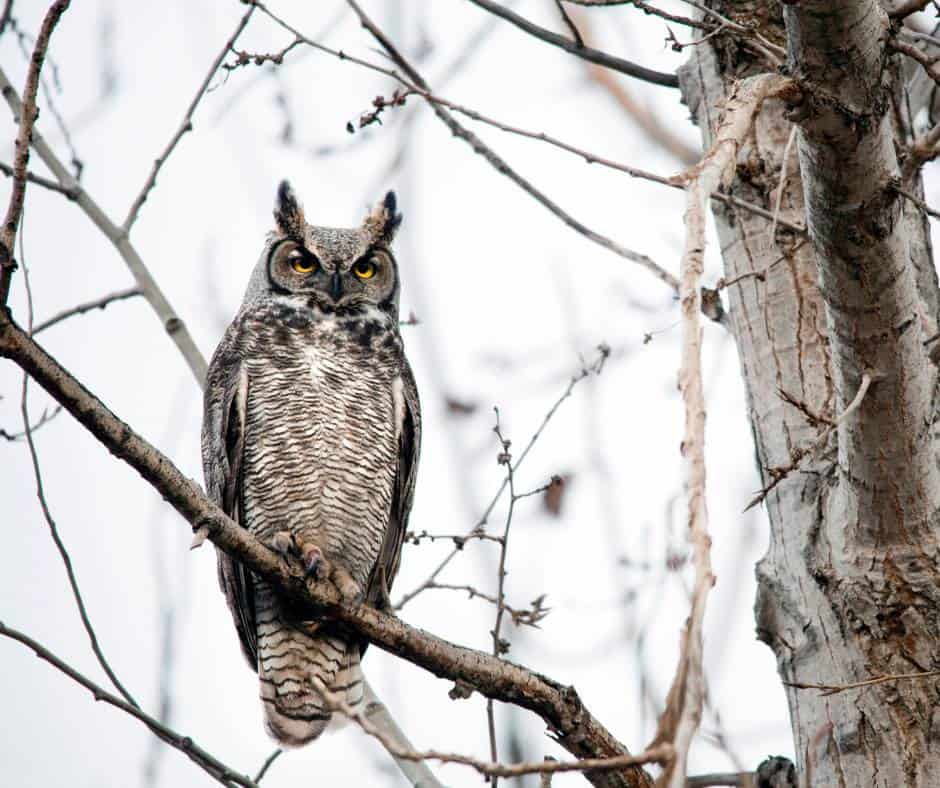
Conservation Status of this California Bird of Prey: The Great Horned Owl is a Species of Least Concern.
Where in California can I see Great Horned Owls?
Great Horned Owls are highly adaptable and can be found in a wide range of habitats including forests, deserts, wetlands, grasslands, and urban areas. They are commonly found in both dense forests and open habitats with scattered trees, as they require perches for hunting and nesting.
There range is basically all over California. In suburban Orange County where I live, we have a Great Horned Owl that lives in our nieghborhood and can often be heard calling in the middle of the night. It is always neat to find him on the roof of one of the homes in our cul de sac.
Great Horned Owl Description and Identification Tips

The Great Horned Owl is a large owl with prominent ear tufts and distinctive yellow eyes. It is one of the most widespread and adaptable owl species in North America and can be found in a variety of habitats in California.
It has a body length of around 18 to 25 inches and a wingspan of about 3 to 5 feet. They weigh 2-4 pounds. They have prominent ear tufts or “horns” on their heads, which are not actual horns but rather tufts of feathers.
Their plumage is mottled and varies in color from grayish-brown to reddish-brown, providing excellent camouflage in their woodland habitats. They have a facial disk, which helps funnel sound towards their ears.
They have a distinctive hooting call that sounds like “hoo-hoo-hoo-hoo,” with the last note lower and drawn out.
Great Horned Owls are opportunistic predators and have a diverse diet. They use their sharp beaks and talons to kill rabbits, squirrels, rats, mice, and voles. They also prey on birds of various sizes, including other owls, waterfowl, songbirds, and occasionally even larger species like herons or raptors. They may also feed on reptiles, amphibians, and insects.
Great Horned Owls typically mate for life and form long-term pair bonds. They build nests on tree branches, in tree cavities, or even on the ground. They are known for taking over abandoned nests of other large birds such as hawks or crows.
The female lays 1-4 eggs, and both parents participate in incubating the eggs and caring for the young. The chicks, known as owlets, hatch after about a month and stay with their parents for several months before becoming independent. Threach maturity after 2-3 years and live for 15-20 years.
23. Western Screech Owl
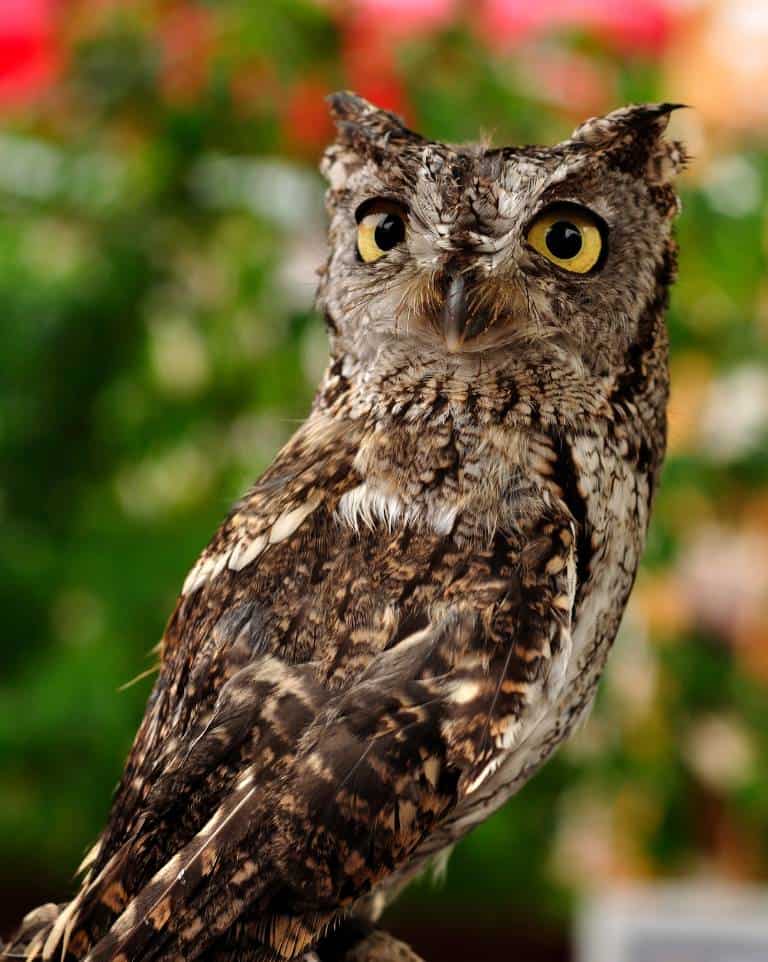
Conservation Status of this California Bird of Prey: Western Screech Owls are Species of Least Concern.
Where in California can I see Western Screech Owls?
Western Screech Owls inhabit forests, woodlands, and suburban areas across California. They are found more frequently found at lower elevations and often roost in tree cavities, abandoned woodpecker holes, or nest boxes. Look for them in forests, woodlands, riparian areas, canyons, and suburban parks and gardens.
Western Screech Owl Description and Identification Tips
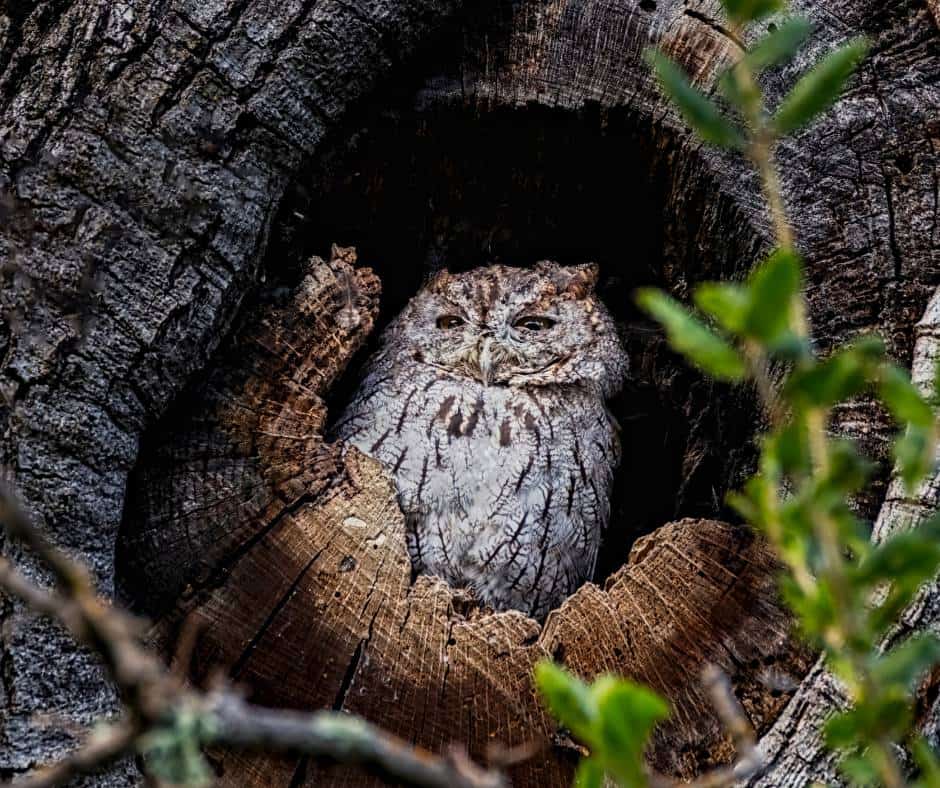
The Western Screech Owl is a small owl with a rounded head and prominent ear tufts. The are typically 8-10 inches in length and weigh just 4-8 ounces. It has a range of plumage variations, including gray and reddish-brown morphs, which provide excellent camouflage against tree bark.
Western Screech Owls can be found in a range of habitats, including forests, woodlands, riparian areas, canyons, and suburban parks and gardens. They often roost in tree cavities, abandoned woodpecker holes, or nest boxes.
Like most owls, Western Screech Owls are primarily active at night. They hunt for small mammals like mice and voles as well as birds, insects, and other prey using their excellent hearing and night vision. They are also known to eat reptiles, amphibians, and invertebrates.
The call of the Western Screech Owl is a distinctive trilling or whinnying sound, often described as a series of soft, descending whistles. Their calls can be heard during the breeding season as well as during territorial disputes or encounters with other owls.
Western Screech Owls typically breed from late winter to early spring. They lay 2-5 eggs in a tree cavity or nest box, which are incubated by the female for about a month.
The young owls leave the nest after several weeks but may remain dependent on their parents for some time. They reach maturity after a year but may not breed for another year. They live 10-15 years in the wild.
24. Northern Pgymy Owl
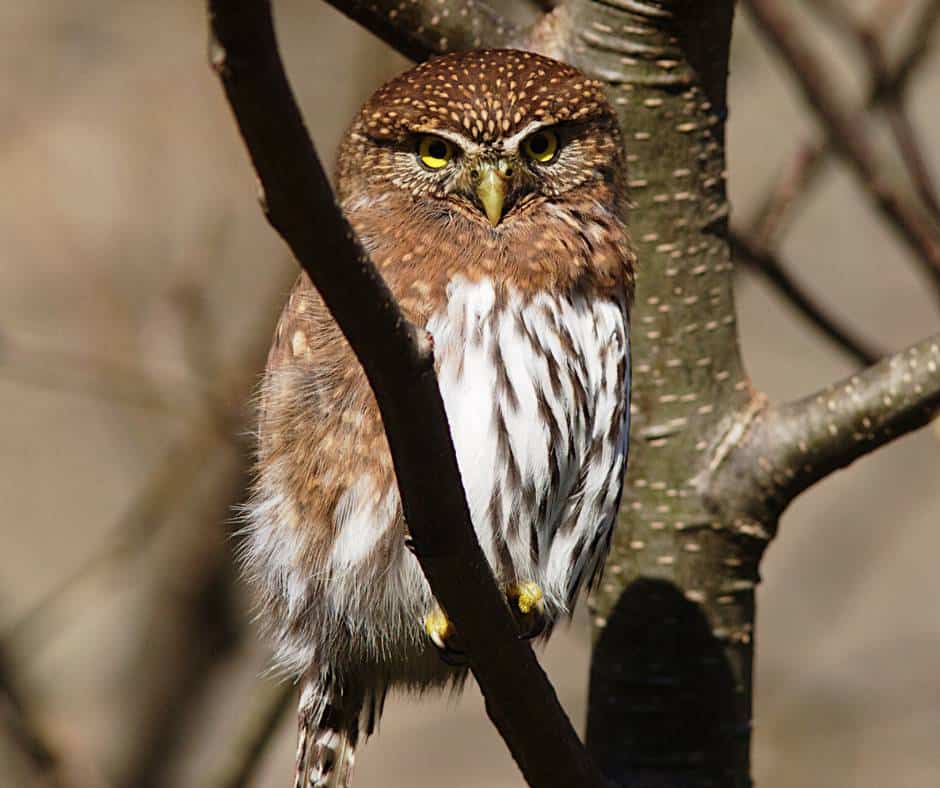
Conservation Status of this California Bird of Prey:The Northern Pygmy Owl is a Species of Least Concern.
Where in California can I see Northern Pygmy Owls?
These owls are most often found in coniferous forests and mixed woodlands of California. Northern Pygmy Owls are relatively small and well-camouflaged, making them challenging to spot. They are primarily active during the day, so keep an eye out during daylight hours and listen for their distinctive calls.
They can be found in the higher elevation forests of the Sierra Nevada range, including areas such as Yosemite National Park, Sequoia and Kings Canyon National Parks, and the Tahoe National Forest. Forested areas along the northern coast of California, such as Redwood National and State Parks and Humboldt Redwoods State Park, are also habitats for the Northern Pygmy Owl.
Forested areas in the central part of the state, including parts of the Los Padres National Forest and the Stanislaus National Forest, may provide opportunities to spot Northern Pygmy Owls. The mountainous regions of Southern California, such as the San Bernardino and San Jacinto Mountains are also home to this owl.
Northern Pygmy Owl Description and Identification tips
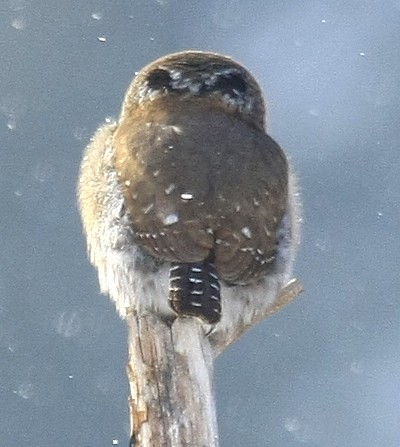
The Northern Pygmy-Owl is a small owl with a relatively long tail and a round head lacking prominent ear tufts. It is one of the smallest owl species in North America, measuring about 6-7 inches in length and weighing just 2.5-3.5 ounces.
It has a rounded head with bright yellow eyes and lacks ear tufts. The plumage varies but typically includes a mix of brown, gray, and white feathers, providing excellent camouflage in forested habitats.
Despite their small size, Northern Pygmy Owls are formidable predators. They primarily hunt during the day and are known for their agility and ability to capture prey larger than themselves. Their diet consists mainly of small birds like sparrows, warblers, and finches, as well as voles, mice, and insects
The Northern Pygmy Owl has a distinctive call that consists of a series of whistling or tooting notes. The male’s call is higher-pitched and more melodious, while the female’s call is lower and harsher. They use vocalizations to communicate with their mate, establish territories, and potentially attract prey.
Northern Pygmy Owls breed in late winter or early spring. They typically nest in tree cavities, often reusing old woodpecker holes or using natural tree cavities. The female lays a clutch of 3-7 eggs, which are incubated by both parents for about 3 weeks.
After hatching, the young owls stay in the nest for several weeks before fledging. They reach maturity after a year and live 3-7 years.
25. Burrowing Owl

Conservation Status of this California Bird of Prey: The Burrowing Owl is a Species of Special Concern due to habitat loss.
Where in California can I see Burrowing Owls?
Burrowing Owls can be found in grasslands and open areas in parts of California.
They can be found in the Central Valley of California, including areas around Bakersfield, Merced, Modesto, Fresno, and Stockton. They are also often found in agricultural fields, and vacant lots.
In the Sacramento Valley, they are quite common around Sacramento, Davis, and Redding. I remember seeing quite a few of these little guys out in the fields when I was studying raptors at UC Davis.
Along the Central Coast, they are most likely to be seen in Carrrizo Plain National Monument and the Santa Maria Valley. In SoCal, the Antelope Valley, Imperial Valley, and Mojave Desert are the best places to see burrowing owls. They can be found in open desert habitats, grasslands, and even near more urban areas with suitable nesting sites.
Burrowing Owl Description and Identification tips

The Burrowing Owl is a small, ground-dwelling owl with a distinctive appearance. It has long legs, short tail, and bright yellow eyes. It nests in underground burrows, often repurposing burrows made by other animals.
Burrowing Owls are small, measuring around 7-11 inches in length, with a wingspan of about 20 inches and a weight of 5-8.5 ounces.. They have a round head, long legs, and a short tail. Their plumage is typically brownish with white or pale spots, and they have bright yellow eyes.
As their name suggests, Burrowing Owls are known for nesting and roosting in burrows. They can be found in open grasslands, deserts, agricultural fields, prairies, and other open habitats with low vegetation. They rely on burrows created by other animals, such as ground squirrels or prairie dogs, or they may dig their own burrows.
Burrowing Owls face various conservation challenges due to habitat loss and degradation. Their reliance on burrows makes them vulnerable to land development and the destruction of nesting sites.
They are protected under state and federal laws, and conservation efforts focus on preserving suitable habitat and creating artificial burrows to support their population.
Burrowing Owls are monogamous and form long-term pair bonds. They breed in the spring and females lay around 6-12 eggs. The incubation period lasts about 28-30 days, and both parents take turns incubating the eggs and caring for the young.
The young owlets leave the nest after approximately 3-4 weeks but continue to be dependent on their parents for several more weeks. They start breeding when they are about two years old and only live for 6-8 years.
26. Barn Owl

Conservation Status of this California Bird of Prey: Barn Owls are A Species of Least Concern.
Where in California can I see Barn Owls?
Barn Owls are one of the most common California birds of prey. They live throughout California except for in the highest elevations. They inhabit a wide range of habitats, including grasslands, agricultural fields, open woodlands, marshes, and even urban areas. They are even found in the desert, but not in as large of numbers.
They are often found near open areas with suitable nesting sites, such as barns, abandoned buildings, birdge girders, cliffs, and tree cavities.
Barn Owl Description and Identification Tips

The Barn Owl is a medium-sized owl known for its heart-shaped face and pale plumage. It is primarily nocturnal and hunts small mammals in open habitats such as fields, meadows, and marshes .
Barn Owls have a distinctive appearance with a heart-shaped face and dark eyes. They have pale, creamy plumage with mottled shades of brown, gray, and white. Their wings are long and broad, allowing for silent flight.
They are primarily nocturnal birds with exceptional low-light vision and acute hearing, which helps them locate prey in the dark. they feed primarily on mall mammals, such as mice, voles, rats, and shrews. They also eat some birds, reptiles, and insects. They hunt by silently flying over their hunting grounds and capturing prey with their sharp talons.
Barn Owls are known for their unique nesting behavior. They don’t build their own nests but instead use existing structures or cavities. They may occupy barns, tree hollows, cliff ledges, or nest boxes.
These owls are monogamous and form long term bonds. The females lay 4-7 eggs and both parents help incubate the eggs which take abotu a month to hatch. Young fledge after 8 to 10 week and reach maturity after one year. The live for 4-5 years in the wild.
27. Long-Eared Owl

Conservation Status of this California Bird of Prey: Long-eared Owls are a Species of Special Concern. Long-eared Owls face various threats including habitat loss, degradation, and fragmentation, as well as disturbance at nesting sites.
Where in California can I see Long-eared Owls?
Long-eared Owls live in dense woodlands, conifer forests, oak woodlands, and riparian areas of California. They can be elusive and difficult to spot due to their excellent camouflage and secretive behavior.
They can be found in these habitats in the Sacramento Valley, San Joaquin Valley, Yosemite National Park, Sequoia National Park, Big Sur, Humboldt County, Mendocino County San Diego County, Los Angeles County, and Orange County.
Long-eared Owl Description and Identification Tips

The Long-eared Owl is a medium-sized owl with long ear tufts that are often difficult to see. It has a slim and elongated body with long ear tufts on the top of its head. It has a mottled brown and buff plumage with streaks and bars, providing excellent camouflage in its woodland habitat. The facial disc is pale with a dark border, and the eyes are orange or yellow.
Long-eared Owls prefer dense woodlands, including coniferous forests and mixed forests. They are also found in riparian areas, groves, and sometimes even in urban parks and gardens.
Long-eared Owls are nocturnal and mainly active during the night. They have excellent hearing and rely on it more than their sight for hunting. They are stealthy hunters, relying on their ability to silently fly and capture small mammals, including mice, voles, and shrews. They may also feed on small birds and insects.
Long-eared Owls typically nest in dense tree foliage, using old nests built by other birds or selecting tree cavities. They may also use abandoned buildings, cliffs, or ground nests. The female lays a clutch of 3-8 eggs, which are incubated by both parents for about a month.
The young owls leave the nest after about 4-5 weeks. They reach maturity after a year, typically start breeding at two years, and live for 4-5 years.
28. Short-Eared Owl
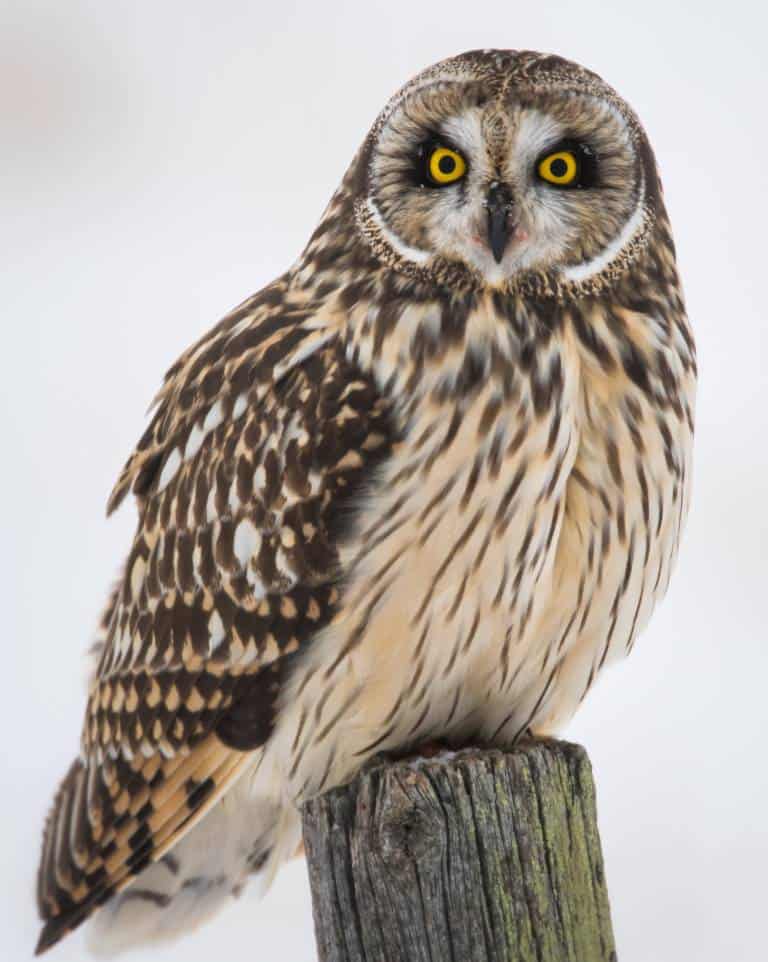
Conservation Status of this California Bird of Prey: Short-eared Owls are considered to be a Species of Special Concern. This is due to habitat loss, degradation, and changes in agricultural practices. Loss of grassland habitats and increased use of pesticides can negatively impact their populations.
Where in California can I see Short-eared Owls?
Short-eared Owls have been observed in various parts of California, including coastal areas, grasslands, and marshes. They can be found in regions such as the Central Valley, Sacramento-San Joaquin Delta, Salton Sea, and coastal areas like San Francisco Bay and Humboldt County.
Short-eared owl Description and Identification Tips

The Short-eared Owl is a medium-sized owl with short ear tufts that are often difficult to see. It has a compact and stocky body with a relatively short tail and broad wings. It has a round head with prominent yellow eyes and small ear tufts (which are usually not visible). The plumage is mottled brown with streaks and spots, providing excellent camouflage.
Short-eared Owls can be found in a range of open habitats such as grasslands, marshes, prairies, agricultural fields, and coastal dunes. They prefer areas with low vegetation cover, which allows them to hunt for small mammals and birds by flying low over the ground.
These owls are often active during the day, especially during dawn and dusk. They have a distinctive flight pattern characterized by buoyant and erratic wingbeats, similar to a moth. Short-eared Owls are known for perching on the ground or low perches like fence posts or shrubs.
Short-eared Owls are ground-nesting birds. They create shallow scrapes on the ground where they lay their eggs, usually in grassy areas or open fields. The female typically lays a clutch of 4 to 7 eggs, and both parents participate in incubating the eggs, which takes about 24 to 28 days.
The chicks fledge around 3 to 4 weeks after hatching. They mature after one year and live for only 3-5 years in the wild.
29. Great Grey Owl

Conservation Status of this California Bird of Prey: Great Grey Owls are Endangered Species in California.
Where in California can I see Great Grey Owls?
Great Grey Owls are in the Sierra Nevada and this population is genetically distinct from the Great Grey Owl populations outside of California.
Yosemite is the southernmost portion of their rang and home to about 300 owls which make up over half the state’s population. This means a visit to Yosemite is your best bet for spotting this owl in California.
Here is our perfect one-day Yosemite itinerary and a great guide featuring over 15 easy hikes in Yosemite. If you love animals you will want to read our guide to animals in Yosemite before your visit as well.
Great Grey Owl Description and Identification Tips
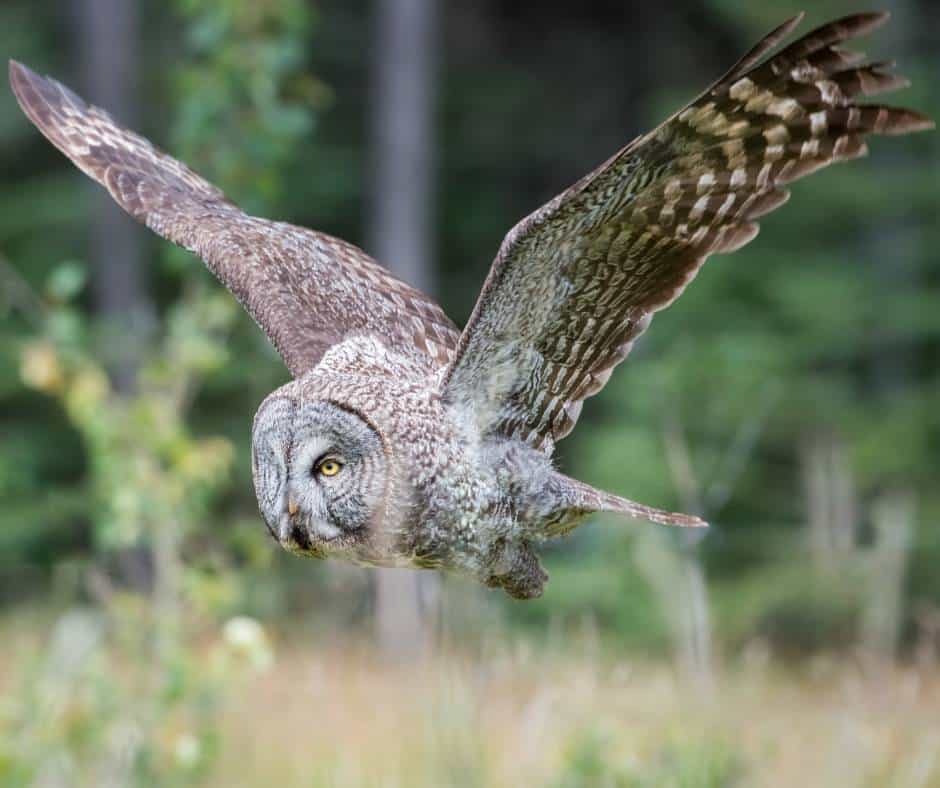
The Great Grey Owl is the largest owl species in length, although it is not the heaviest. They have a height of about 24-33 inches, a wingspan of around 53-60 inches, and weigh 2-4 pounds.
It has a round face with a large facial disc and bright yellow eyes. The plumage is mostly gray, with intricate patterns and bars that provide excellent camouflage against tree bark. It has long wings and a relatively short tail.
Great Grey Owls prefer areas with dense tree cover, particularly where there are old-growth forests with large trees.
These owls are mostly crepuscular and nocturnal, meaning they are active during twilight and night hours. They have excellent hearing and rely on their keen sense of hearing to locate prey in complete darkness. Great Grey Owls primarily feed on small mammals, such as voles, mice, and other rodents.
Great Grey Owls are not known for their hooting calls. Instead, they communicate through a variety of low, soft hoots and whistles.
Female Great Grey Owls lay a clutch of 2 to 5 eggs, which they incubate for about 28 to 35 days. The male provides food for the female during this period. Owlets leave the nest after about 4 to 5 weeks but continue to rely on their parents for several months before becoming independent. They mature after 1-3 years and live for 5-10 years.
30. California Spotted Owl
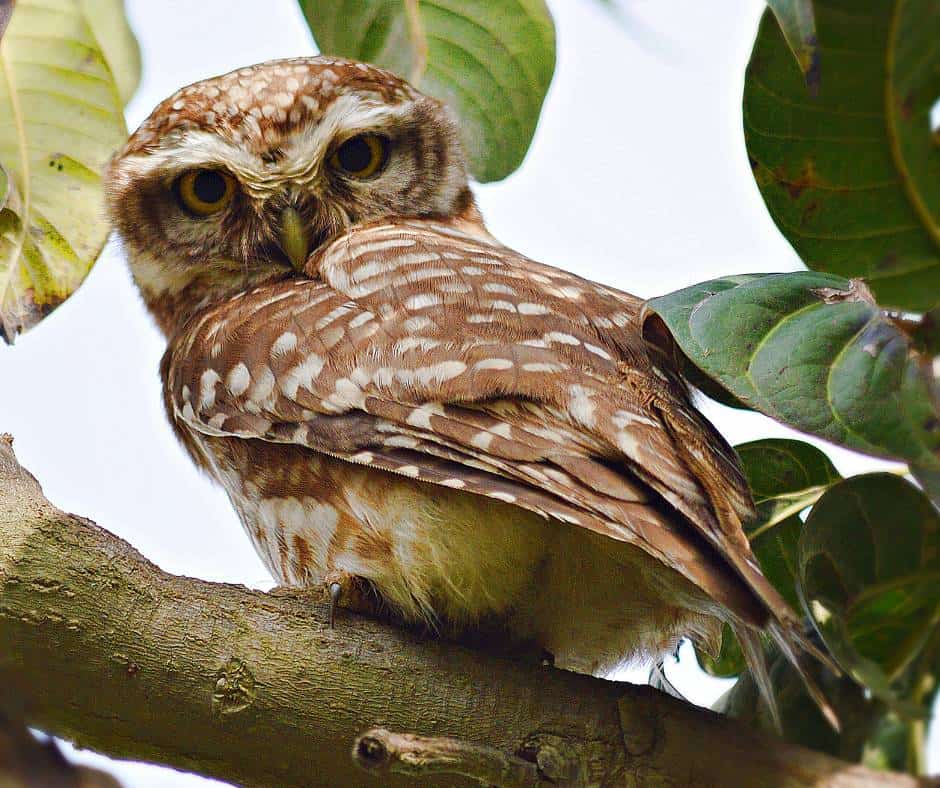
Conservation Status of this California Bird of Prey: California Spotted Owls are Species of Special Concern in California and is listed as a threatened species under the U.S. Endangered Species Act. It faces various threats to its habitat, including logging, wildfires, and habitat fragmentation. The species relies on intact forest ecosystems, and its conservation requires efforts to maintain suitable habitat conditions.
Where in California can I see Spotted Owls?
The California Spotted Owl lives in places with large, old -growth trees and dense canopies. They prefer mixed-conifer forests, including areas dominated by Douglas-fir, white fir, and ponderosa pine. They rely on these habitats for roosting, nesting, and hunting.
They can be found in the Cascade Range up in far northern California (Shasta County), the western slope of the Sierras, and in Southern California’s San Bernardino Mountains.
California Spotted Owl Description and Identification Tips

California Spotted Owls are medium-sized owls, measuring about 16-19 inches in length and weighing around 1.5 pounds. They have dark brown plumage with distinctive white spots on their head, back, and breast. Their facial disc is round and brown with dark brown or black concentric circles around their eyes.
These owls are primarily nocturnal and have a characteristic hooting call, which they use for communication and territorial defense. They feed mainly on small mammals, such as mice, voles, squirrels, and rabbits but will aslo eat birds, reptiles, and invertebrates.
The Spotted Owl does not build its own nest but depends on finding suitable, naturally occurring sites in trees. They will nest in tree cavities or use abandoned nests of other large birds.
These owls are monogamous and form long term pairs over several seasons. Females lays 2-3 eggs, which are incubated by both parents for about 30-35 days. The young owls leave the nest after about 6-7 weeks and become independent after a few months. They reach maturity after two years and live for 10-12 years in the wild.
31. Northern Spotted Owl

Conservation Status of this California Bird of Prey: The Northern Spotted Owl is listed as Threatened under the California and Federal Endangered Species Acts. It faces significant threats due to habitat loss and fragmentation caused by logging, wildfires, and land development. The decline of old-growth forests and the encroachment of the more aggressive Barred Owl species have also contributed to its population decline.
Where in California can I see Northern Spotted Owls?
Northern Spotted Owls live in the coastal range forests of Northern California. They rely on these habitats for nesting, roosting, and hunting. They are typically found at elevations ranging from sea level to mountainous areas. They are found as far south as Marin County and as far east as the Pit River Area in Shasta County.
Northern Spotted Owl Description and Identification Tips

The Northern Spotted Owl is a medium-sized owl, measuring about 17-19 inches in length and weighing around 1.5-2 pounds. Females are typically 20% larger than males. It has dark brown plumage with distinct round spots on its head, back, and underparts. Its facial disc is rounded and dark brown with a pale or grayish rim.
These owls are primarily nocturnal and have excellent low-light vision and acute hearing, which helps them hunt for small mammals like flying squirrels, woodrats, and other rodents. They are known for their silent flight and stealthy hunting techniques.
Northern Spotted Owls typically breed in late winter or early spring. They nest in tree cavities or use abandoned nests of other large birds. The female lays 2-3 eggs, which are incubated by both parents for about 30-35 days.
The young owls, known as fledglings, leave the nest after about 6-7 weeks and become independent after a few months. They mature after two years and live for 10-15 years in the wild.
32. Elf Owls

Conservation Status of this California Bird of Prey: Elf Owls are considered endangered in California due to habitat loss.
Where in California can I see Elf Owls?
Since much of the land along the Arizona border/Colorado River in California has been converted to agriculture, the Elf Owl has suffered tremendous habitat loss in the state. Still, if you are going to see them, along this border region is the place you will spot them.
Elf Owl Description and Identification Tips

Elf Owls are the smallest owls in North America.They measure just 5-6 inches in length and weighonly around 1-1.5 ounces. They have a distinctive rounded head with large yellow eyes and no ear tufts. Their plumage is mainly gray-brown, with white and buff markings on the face and underparts.
They inhabit a variety of habitats, including deserts, scrublands, open woodlands, and riparian areas. They prefer areas with a mix of trees and shrubs, providing suitable nesting sites and a diverse food supply.
These owls are primarily nocturnal and well-adapted for hunting in low-light conditions. They feed on a variety of small prey, including insects (especially moths and beetles), spiders, scorpions, and small rodents. Elf Owls have a distinctive flight pattern characterized by quick, fluttering wingbeats and agile maneuvering through vegetation.
Fun fact: Elf Owls catch blind snakes, which look quite a bit like worms, but they don’t eat them! Instead, the place them in their nestss to eat parasites that might otherwise hurt their owlets!
Read about all the snakes in Southern California, including the blind snake.
Elf Owls are known for their unique and melodious call, which consists of a series of soft, high-pitched notes. They use vocalizations to communicate with their mate, establish territories, and locate each other in the dark.
They nest in tree cavities, often using old woodpecker holes or natural hollows in saguaro cacti. The female lays 2-4 eggs, which are incubated by both parents for about 3 weeks. After hatching, the young owls remain in the nest for another 3-4 weeks before fledging and becoming independent. They reach maturity after a year and live for just 3-5 years.
33. Barred Owls

Conservation Status of this California Bird of Prey: Barred Owls are a species of least concern and considered a nuiscance in California.
Where in California can I see Barred Owls?
Barred Owls have only lived in California for a short time. They were first seen in the state in 1976 and by 2020, 2,000 Barred Owls inhabited the ranges of the Spotted Owls. They are found in Northern California’s coastal forest where the Northern Spotted Owl lives and have recently began to make appearances in the California Spotted Owl’s Sierra Nevada range.
Barred Owl Description and Identification Tips
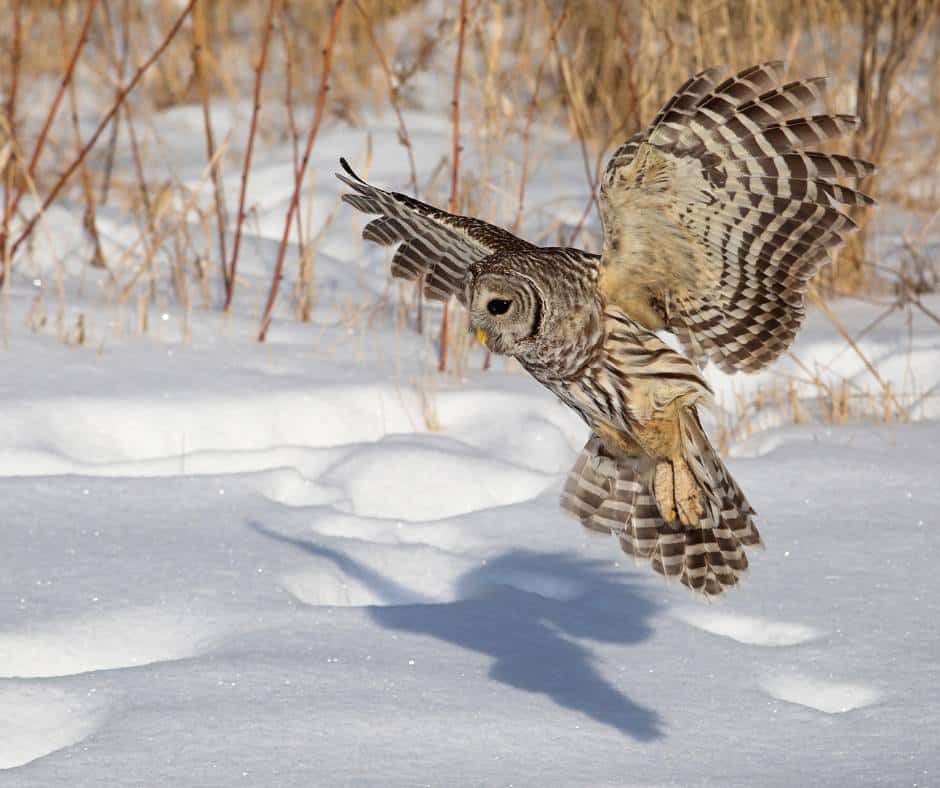
Barred Owls are larger and more aggressive than Spotted Owls. They are also less picky about food options and habitat. Since the Barred Owl entered Spotted Owl habitat, there has been a population decline of the Spotted Owl because they get displaced by the more aggressive owls.
US Fish and Wildlife in currently conducting experiments where they remove the Barred Owls from Northern Spotted Owl habitat to see if that helps the Northern Spotted Owl population grow.
Barred Owls are medium-sized owls. Adults typically measure 16-24 inches in length and have a wingspan of approximately 38-49 inches. They about 1-2.5 pounds and females are generally larger than males.
Barred Owls have a distinctive appearance with a rounded head and no ear tufts. They have large, dark eyes, a pale face with a dark outline, and a hooked beak. Their plumage is primarily brown with horizontal barring on the chest, belly, and wings. The upperparts are mottled brown, while the underparts are lighter with vertical streaks.
These owls are nocturnal, skilled hunters, and primarily feed on small mammals such as mice, voles, squirrels, and rabbits. Barred Owls have a distinctive hooting call, often described as “Who cooks for you? Who cooks for you-all?”
Barred Owls are monogamous and typically mate for life. They nest in tree cavities or abandoned nests of other large birds. The female lays 2-4 eggs which are incubated by both parents for about 28-33 days.
The young owls leave the nest at around 4-5 weeks of age but may continue to be dependent on their parents for several months. They reach maturity after 1-2 years and typically live for 10-15 years in the wild.
Other California Birds of Prey
34. Osprey

Conservation Status of this California Bird of Prey: Osprey are considered a Species of Least Concern.
Where in California can I see Ospreys?
Ospreys can be found throughout California, particularly along the coast, in wetlands, and near bodies of water such as lakes and rivers. The are found south of the Bay Area in the winter, with year-long populations in Marin County and along the Central Coast. They inhabit the northern coastal regions in the summer.
There is also a yearlong population in the lower elevations of the western Sierras, winter population near the Salton Sea, and summer population in the higher elevations of the Sierras.
Osprey Description and Identification Tips
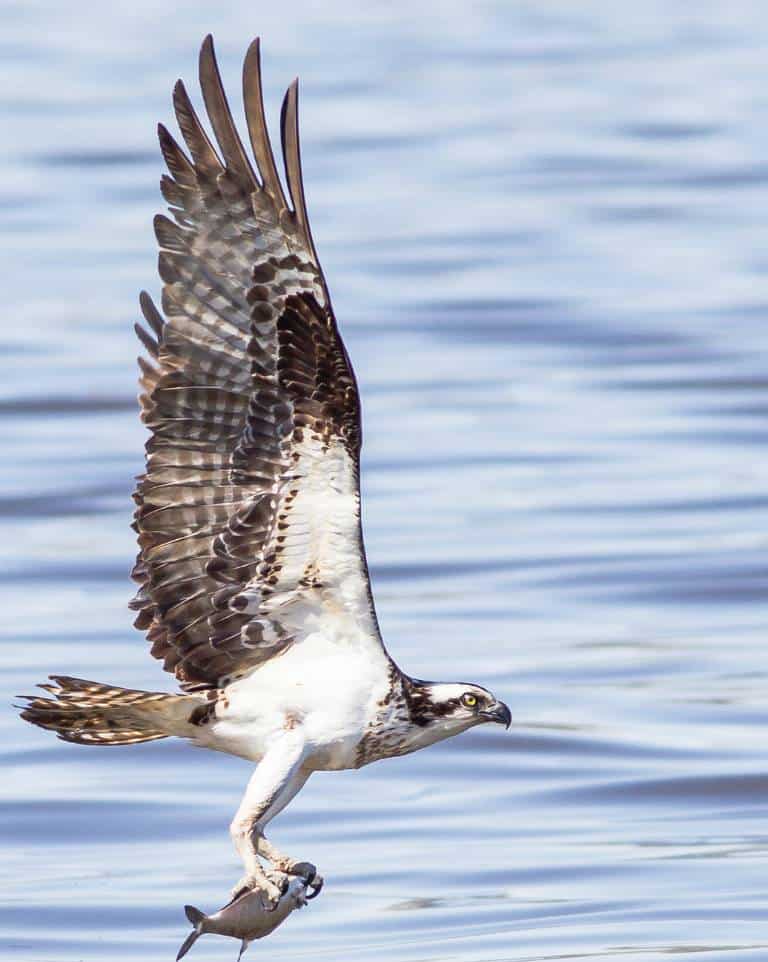
While the Osprey is often referred to as a “fish hawk” or “sea hawk,” it is not a true hawk. Taxonomically, it belongs to its own unique family called Pandionidae. They are large birds of prey with a wingspan of around 4 to 6 feet, body length of nearly two feet, and weight of 3-4.5 pounds.
They have a distinctive appearance with dark brown upperparts and white underparts. Ospreys have a white head and breast with a dark eye stripe extending down to the side of their neck. They also have long, narrow wings and a hooked beak for capturing and feeding on fish.
Ospreys are well adapted for catching fish. They are primarily associated with freshwater or saltwater habitats near bodies of water, such as lakes, rivers, estuaries, and coastal areas.
They have reversible outer toes that allow them to grasp fish with two toes in front and two toes in the back. They are excellent hunters and can spot fish from high above in the air. Ospreys perform dramatic dives, called “plunging dives” or “fish dives,” into the water to catch fish, and then they carry their prey with their feet to take it to a safe place to eat.
Ospreys are monogamous and usually mate for life. They build large nests, called eyries, on high structures such as trees, cliffs, or man-made platforms. Both the male and female participate in nest construction. The female lays 2 to 4 eggs, and both parents take turns incubating them, which typically takes about 5 to 6 weeks. They reach sexual maturity at 3-4 years and live for 10-15 years.

